A Review of Microscale, Rheological, Mechanical, Thermoelectrical and Piezoresistive Properties of Graphene Based Cement Composite
Abstract
:1. Introduction
2. Brief Description of Graphene Nanostructures
3. Classification of Graphene Based on Nanostructure
3.1. Zero Dimensional Graphene Nanoparticles
3.2. One Dimensional Graphene Nanotubes
3.3. Two Dimensional Graphene Sheets
4. Dispersion of Graphene Based Nanomaterials
4.1. Dispersion Using Dispersant
4.2. Dispersion Using Ultrasonication
4.3. Assessment of Dispersion Efficiency Using UV-Vis Spectrometry
5. Characterization of Graphene Cement Composite
5.1. Thermogravimetric Analysis (TGA)
5.2. Infrared Spectroscopic Analysis
5.3. XRD Analysis
5.4. Morphological Analysis
6. Rheological Properties of Graphene Cement Paste
7. Mechanical Properties of Graphene Cement Composite
8. Energy Harvesting and Thermoelectrical Properties of Graphene Cement Composite
9. Piezoresistive Properties of Graphene Cement Composite
10. Discussion and Research Gaps
- (1)
- Very limited research has been found regarding the manufacture of nano-size cement particles and nano-binders however, it has great potential for the development of novel admixtures, nanoparticles, and nano-reinforcements.
- (2)
- Most of the researches on the dispersion of graphene and its derivatives were focused on surface modification, functionalization, and oxidation process. However, these processes damaged the atomic structure of graphene. Therefore, other methods are indispensably required for the dispersion of GNDs and preserving the atomic structure of graphene.
- (3)
- The enhancement mechanism in properties is not completely described as yet. Further research is required to study the regulating mechanism of graphene and its derivatives on hydrated cement crystals.
- (4)
- Flow properties of graphene cement composite and its dependence on various factors are missing in the existing literature. The variation of geometric flow with time, dispersing agent, shear rate and various types of graphene sheets is required to explore the flow of cement paste in the plastic state. Moreover, the best optimized rheological mathematical model needs to be sorted out, as a single rheological model cannot predict the flow behaviour of cement paste accurately. Thus, graphene cement composite demands further exploration to achieve maximum benefit from graphene.
- (5)
- The complete mechanism for accelerating the hydration reactions and enhancing overall mechanical properties has not been explained. Prominent differences in mechanical properties were found in experimental work conducted by various researchers under similar experimental conditions.
- (6)
- The distance between the current and voltage poles is required to be optimized for four-probe method. The potential application of graphene-based cement composite as an embedded smart sensor in the real concrete structure was seldom found in the literature. Moreover, the suitability, industrial demand, and compatibility of graphene cement smart sensors with the existing non-destructive health monitoring methods need to be determined.
11. Conclusions
Author Contributions
Funding
Acknowledgments
Conflicts of Interest
References
- Barcelo, L.; Kline, J.; Walenta, G.; Gartner, E. Cement and carbon emissions. Mater. Struct. 2014, 47, 1055–1065. [Google Scholar] [CrossRef]
- Kodur, V.; Sultan, M. Effect of temperature on thermal properties of high-strength concrete. J. Mater. Civ. Eng. 2003, 15, 101–107. [Google Scholar] [CrossRef]
- Javed, M.F.; Hafizah, N.; Memon, S.A.; Jameel, M.; Aslam, M. Recent research on cold-formed steel beams and columns subjected to elevated temperature: A review. Constr. Build. Mater. 2017, 144, 686–701. [Google Scholar] [CrossRef]
- Birchall, J.; Howard, A.; Kendall, K. Flexural strength and porosity of cements. Nature 1981, 289, 388–390. [Google Scholar] [CrossRef]
- Hanehara, S.; Yamada, K. Interaction between cement and chemical admixture from the point of cement hydration, absorption behaviour of admixture, and paste rheology. Cem. Concr. Res. 1999, 29, 1159–1165. [Google Scholar] [CrossRef]
- Zhang, M.-H.; Sisomphon, K.; Ng, T.S.; Sun, D.J. Effect of superplasticizers on workability retention and initial setting time of cement pastes. Constr. Build. Mater. 2010, 24, 1700–1707. [Google Scholar] [CrossRef]
- Bessaies-Bey, H.; Baumann, R.; Schmitz, M.; Radler, M.; Roussel, N. Organic admixtures and cement particles: Competitive adsorption and its macroscopic rheological consequences. Cem. Concr. Res. 2016, 80, 1–9. [Google Scholar] [CrossRef]
- Flatt, R.J.; Houst, Y.F. A simplified view on chemical effects perturbing the action of superplasticizers. Cem. Concr. Res. 2001, 31, 1169–1176. [Google Scholar] [CrossRef]
- Rehman, S.K.U.; Ibrahim, Z.; Memon, S.A.; Jameel, M. Nondestructive test methods for concrete bridges: A review. Constr. Build. Mater. 2016, 107, 58–86. [Google Scholar] [CrossRef] [Green Version]
- Javed, M.F.; Sulong, N.H.R.; Memon, S.A.; Rehman, S.K.U.; Khan, N.B. FE modelling of the flexural behaviour of square and rectangular steel tubes filled with normal and high strength concrete. Thin-Walled Struct. 2017, 119, 470–481. [Google Scholar] [CrossRef]
- Lothenbach, B.; Scrivener, K.; Hooton, R.D. Supplementary cementitious materials. Cem. Concr. Res. 2011, 41, 1244–1256. [Google Scholar] [CrossRef]
- Richardson, I.; Groves, G. The structure of the calcium silicate hydrate phases present in hardened pastes of white Portland cement/blast-furnace slag blends. J. Mater. Sci. 1997, 32, 4793–4802. [Google Scholar] [CrossRef]
- Shi, C.; Qian, J. High performance cementing materials from industrial slags—A review. Resour. Conserv. Recycl. 2000, 29, 195–207. [Google Scholar] [CrossRef]
- Yoo, D.-Y.; Banthia, N.; Fujikake, K.; Borges, P.H.; Gupta, R. Advanced Cementitious Materials: Mechanical Behavior, Durability, and Volume Stability. Adv. Mater. Sci. Eng. 2017, 2017, 1–2. [Google Scholar] [CrossRef] [PubMed] [Green Version]
- Dawood, E.T.; Ramli, M. High strength characteristics of cement mortar reinforced with hybrid fibres. Constr. Build. Mater. 2011, 25, 2240–2247. [Google Scholar] [CrossRef]
- Chung, D.D.L. Comparison of submicron-diameter carbon filaments and conventional carbon fibers as fillers in composite materials. Carbon 2001, 39, 1119–1125. [Google Scholar] [CrossRef]
- Juárez, C.; Valdez, P.; Durán, A.; Sobolev, K. The diagonal tension behavior of fiber reinforced concrete beams. Cem. Concr. Compos. 2007, 29, 402–408. [Google Scholar] [CrossRef]
- Topçu, İ.B.; Canbaz, M. Effect of different fibers on the mechanical properties of concrete containing fly ash. Constr. Build. Mater. 2007, 21, 1486–1491. [Google Scholar] [CrossRef]
- Yoo, D.-Y.; Banthia, N.; Fujikake, K.; Kim, Y.H.; Gupta, R. Fiber-Reinforced Cement Composites: Mechanical Properties and Structural Implications 2019. Adv. Mater. Sci. Eng. 2019, 2019, 1–2. [Google Scholar] [CrossRef] [Green Version]
- Konsta, G.M.S.; Metaxa, Z.S.; Shah, S.P. Multi-scale mechanical and fracture characteristics and early-age strain capacity of high performance carbon nanotube/cement nanocomposites. Cem. Concr. Compos. 2010, 32, 110–115. [Google Scholar] [CrossRef]
- Chuah, S.; Pan, Z.; Sanjayan, J.G.; Wang, C.M.; Duan, W.H. Nano reinforced cement and concrete composites and new perspective from graphene oxide. Constr. Build. Mater. 2014, 73, 113–124. [Google Scholar] [CrossRef]
- Xu, Y.; Fan, Y. Effects of Graphene Oxide Dispersion on Salt-Freezing Resistance of Concrete. Adv. Mater. Sci. Eng. 2020, 2020, 1–9. [Google Scholar] [CrossRef]
- Liu, C.; Liu, G.; Ge, Z.; Guan, Y.; Cui, Z.; Zhou, J. Mechanical and Self-Sensing Properties of Multiwalled Carbon Nanotube-Reinforced ECCs. Adv. Mater. Sci. Eng. 2019, 2019, 1–9. [Google Scholar] [CrossRef] [Green Version]
- Sanchez, F.; Sobolev, K. Nanotechnology in concrete—A review. Constr. Build. Mater. 2010, 24, 2060–2071. [Google Scholar] [CrossRef]
- Fraga, J.L.; del Campo, J.M.; García, J.Á. Carbon nanotube-cement composites in the construction industry: 1952–2014. A state of the art review. In Proceedings of the 2nd International Conference on Emerging Trends in Engineering and Technology (ICETET’2014), London, UK, 30–31 May 2014. [Google Scholar]
- Han, B.; Sun, S.; Ding, S.; Zhang, L.; Yu, X.; Ou, J. Review of nanocarbon-engineered multifunctional cementitious composites. Compos. Part A Appl. Sci. Manuf. 2015, 70, 69–81. [Google Scholar] [CrossRef]
- Qureshi, T.S.; Panesar, D.K. A review: The effect of graphene oxide on the properties of cement-based composites. In Proceedings of the CSCE Annual Conference, Vancouver, BC, Canada, 31 May–3 June 2017; p. 642-1. [Google Scholar]
- Yang, H.; Cui, H.; Tang, W.; Li, Z.; Han, N.; Xing, F. A critical review on research progress of graphene/cement based composites. Compos. Part A Appl. Sci. Manuf. 2017, 102, 273–296. [Google Scholar] [CrossRef]
- Liu, C.; Huang, X.; Wu, Y.-Y.; Deng, X.; Liu, J.; Zheng, Z.; Hui, D. Review on the research progress of cement-based and geopolymer materials modified by graphene and graphene oxide. Nanotechnol. Rev. 2020, 9, 155. [Google Scholar] [CrossRef] [Green Version]
- Zhao, L.; Guo, X.; Song, L.; Song, Y.; Dai, G.; Liu, J. An intensive review on the role of graphene oxide in cement-based materials. Constr. Build. Mater. 2020, 241, 117939. [Google Scholar] [CrossRef]
- Novoselov, K.; Geim, A.K.; Morozov, S.V.; Jiang, D.; Zhang, Y.; Dubonos, S.V.; Grigorieva, I.V.; Firsov, A.A. Electric field effect in atomically thin carbon films. Science 2004, 306, 666–669. [Google Scholar] [CrossRef] [Green Version]
- Alkhateb, H.; Al-Ostaz, A.; Cheng, A.H.-D.; Li, X. Materials genome for graphene-cement nanocomposites. J. Nanomech. Micromech. 2013, 3, 67–77. [Google Scholar] [CrossRef]
- Wang, B.; Jiang, R.; Wu, Z. Investigation of the mechanical properties and microstructure of graphene nanoplatelet-cement composite. Nanomaterials 2016, 6, 200. [Google Scholar] [CrossRef]
- Segal, M. Selling graphene by the ton. Nat Nano 2009, 4, 612–614. [Google Scholar] [CrossRef]
- Novoselov, K.; Fal, V.; Colombo, L.; Gellert, P.; Schwab, M.; Kim, K. A roadmap for graphene. Nature 2012, 490, 192–200. [Google Scholar] [CrossRef]
- Rehman, S.K.U.; Imtiaz, L.; Aslam, F.; Khan, M.K.; Haseeb, M.; Javed, M.F.; Alyousef, R.; Alabduljabbar, H. Experimental Investigation of NaOH and KOH Mixture in SCBA-Based Geopolymer Cement Composite. Materials 2020, 13, 3437. [Google Scholar] [CrossRef]
- Bai, H.; Li, C.; Shi, G. Functional composite materials based on chemically converted graphene. Adv. Mater. 2011, 23, 1089–1115. [Google Scholar] [CrossRef] [PubMed]
- Sun, S.; Yu, X.; Han, B.; Ou, J. In situ growth of carbon nanotubes/carbon nanofibers on cement/mineral admixture particles: A review. Constr. Build. Mater. 2013, 49, 835–840. [Google Scholar] [CrossRef]
- Geim, A.K.; Novoselov, K.S. The rise of graphene. In Nanoscience and Technology: A Collection of Reviews from Nature Journals; World Scientific: London, UK, 2010; pp. 11–19. [Google Scholar]
- Kuilla, T.; Bhadra, S.; Yao, D.; Kim, N.H.; Bose, S.; Lee, J.H. Recent advances in graphene based polymer composites. Prog. Polym. Sci. 2010, 35, 1350–1375. [Google Scholar] [CrossRef]
- Kroto, H.W.; Heath, J.R.; O’Brien, S.C.; Curl, R.F.; Smalley, R.E. C60: Buckminsterfullerene. Nature 1985, 318, 162–163. [Google Scholar] [CrossRef]
- Long, X.; Sun, M.-Q.; Li, Z.-Q.; Song, X.-H. Piezo-resistive Effects in Carbon Black-filled Cement-matrix Nanocomposites. J. Wuhan Univ. Technol. 2008, 3, 57–59. [Google Scholar]
- Gong, H.; Li, Z.; Zhang, Y.; Fan, R. Piezoelectric and dielectric behavior of 0-3 cement-based composites mixed with carbon black. J. Eur. Ceram. Soc. 2009, 29, 2013–2019. [Google Scholar] [CrossRef]
- Wang, P.; Ding, T.; Xu, F.; Qin, Y. Piezoresistivity of conductive composites filled by carbon black particles. Fuhe Cailiao Xuebao (Acta Mater. Compos. Sin.) 2004, 21, 34–38. [Google Scholar]
- Gao, Y.-M.; Shim, H.-S.; Hurt, R.H.; Suuberg, E.M.; Yang, N.Y. Effects of carbon on air entrainment in fly ash concrete: The role of soot and carbon black. Energy Fuels 1997, 11, 457–462. [Google Scholar] [CrossRef]
- Agrawal, S.; Raghuveer, M.S.; Ramprasad, R.; Ramanath, G. Multishell Carrier Transport in Multiwalled Carbon Nanotubes. Nanotechnol. IEEE Trans. 2007, 6, 722–726. [Google Scholar] [CrossRef]
- Konsta, G.M.S.; Metaxa, Z.S.; Shah, S.P. Highly dispersed carbon nanotube reinforced cement based materials. Cem. Concr. Res. 2010, 40, 1052–1059. [Google Scholar] [CrossRef]
- Li, G.Y.; Wang, P.M.; Zhao, X. Mechanical behavior and microstructure of cement composites incorporating surface-treated multi-walled carbon nanotubes. Carbon 2005, 43, 1239–1245. [Google Scholar] [CrossRef]
- Ma, P.-C.; Siddiqui, N.A.; Marom, G.; Kim, J.-K. Dispersion and functionalization of carbon nanotubes for polymer-based nanocomposites: A review. Compos. Part A Appl. Sci. Manuf. 2010, 41, 1345–1367. [Google Scholar] [CrossRef]
- Cwirzen, A.; Habermehl-Cwirzen, K.; Nasibulin, A.G.; Kaupinen, E.I.; Mudimela, P.R.; Penttala, V. SEM/AFM studies of cementitious binder modified by MWCNT and nano-sized Fe needles. Mater. Charact. 2009, 60, 735–740. [Google Scholar] [CrossRef]
- Cwirzen, A. Controlling physical properties of cementitious matrixes by nanomaterials. Adv. Mater. Res. 2010, 123, 639–642. [Google Scholar] [CrossRef]
- Kim, J.; Cote, L.J.; Kim, F.; Yuan, W.; Shull, K.R.; Huang, J. Graphene Oxide Sheets at Interfaces. J. Am. Chem. Soc. 2010, 132, 8180–8186. [Google Scholar] [CrossRef]
- Ramanathan, T.; Abdala, A.A.; Stankovich, S.; Dikin, D.A.; Herrera Alonso, M.; Piner, R.D.; Adamson, D.H.; Schniepp, H.C.; Chen, X.; Ruoff, R.S.; et al. Functionalized graphene sheets for polymer nanocomposites. Nat. Nano 2008, 3, 327–331. [Google Scholar] [CrossRef]
- Kim, H.; Miura, Y.; Macosko, C.W. Graphene/Polyurethane Nanocomposites for Improved Gas Barrier and Electrical Conductivity. Chem. Mater. 2010, 22, 3441–3450. [Google Scholar] [CrossRef]
- Pan, Z.; He, L.; Qiu, L.; Korayem, A.H.; Li, G.; Zhu, J.W.; Collins, F.; Li, D.; Duan, W.H.; Wang, M.C. Mechanical properties and microstructure of a graphene oxide–cement composite. Cem. Concr. Compos. 2015, 58, 140–147. [Google Scholar] [CrossRef]
- Wilson, N.R.; Pandey, P.A.; Beanland, R.; Young, R.J.; Kinloch, I.A.; Gong, L.; Liu, Z.; Suenaga, K.; Rourke, J.P.; York, S.J. Graphene oxide: Structural analysis and application as a highly transparent support for electron microscopy. ACS Nano 2009, 3, 2547–2556. [Google Scholar] [CrossRef] [PubMed]
- Zhang, Y.; Tan, Y.-W.; Stormer, H.L.; Kim, P. Experimental observation of the quantum Hall effect and Berry’s phase in graphene. Nature 2005, 438, 201–204. [Google Scholar] [CrossRef] [Green Version]
- Ferrari, A.C.; Meyer, J.C.; Scardaci, V.; Casiraghi, C.; Lazzeri, M.; Mauri, F.; Piscanec, S.; Jiang, D.; Novoselov, K.S.; Roth, S.; et al. Raman Spectrum of Graphene and Graphene Layers. Phys. Rev. Lett. 2006, 97, 187401. [Google Scholar] [CrossRef] [Green Version]
- Lee, C.; Wei, X.; Kysar, J.W.; Hone, J. Measurement of the elastic properties and intrinsic strength of monolayer graphene. Science 2008, 321, 385–388. [Google Scholar] [CrossRef]
- Boehm, H.; Clauss, A.; Fischer, G.; Hofmann, U. Surface properties of extremely thin graphite lamellae. In Proceedings of Fifth Conference on Carbon; Pergamon Press: New York, NY, USA, 1962; pp. 73–80. [Google Scholar]
- Zhu, Y.; Murali, S.; Cai, W.; Li, X.; Suk, J.W.; Potts, J.R.; Ruoff, R.S. Graphene and graphene oxide: Synthesis, properties, and applications. Adv. Mater. 2010, 22, 3906–3924. [Google Scholar] [CrossRef]
- Balandin, A.A.; Ghosh, S.; Bao, W.; Calizo, I.; Teweldebrhan, D.; Miao, F.; Lau, C.N. Superior thermal conductivity of single-layer graphene. Nano Lett. 2008, 8, 902–907. [Google Scholar] [CrossRef]
- Lin, J.; Teweldebrhan, D.; Ashraf, K.; Liu, G.; Jing, X.; Yan, Z.; Li, R.; Ozkan, M.; Lake, R.K.; Balandin, A.A. Gating of Single-Layer Graphene with Single-Stranded Deoxyribonucleic Acids. Small 2010, 6, 1150–1155. [Google Scholar] [CrossRef]
- Geim, A.K.; Novoselov, K.S. The rise of graphene. Nat. Mater. 2007, 6, 183–191. [Google Scholar] [CrossRef]
- Lee, C.; Wei, X.; Li, Q.; Carpick, R.; Kysar, J.W.; Hone, J. Elastic and frictional properties of graphene. Phys. Status Solidi (B) 2009, 246, 2562–2567. [Google Scholar] [CrossRef]
- Mak, K.F.; Lee, C.; Hone, J.; Shan, J.; Heinz, T.F. Atomically thin MoS 2: A new direct-gap semiconductor. Phys. Rev. Lett. 2010, 105, 136805. [Google Scholar] [CrossRef] [PubMed] [Green Version]
- Rafiee, M.A.; Lu, W.; Thomas, A.V.; Zandiatashbar, A.; Rafiee, J.; Tour, J.M.; Koratkar, N.A. Graphene nanoribbon composites. ACS Nano 2010, 4, 7415–7420. [Google Scholar] [CrossRef] [PubMed]
- Grobert, N. Carbon nanotubes—Becomng clean. Materialstoday 2007, 10, 28–35. [Google Scholar]
- Ubertini, F.; Laflamme, S.; Ceylan, H.; Materazzi, A.L.; Cerni, G.; Saleem, H.; D’Alessandro, A.; Corradini, A. Novel nanocomposite technologies for dynamic monitoring of structures: A comparison between cement-based embeddable and soft elastomeric surface sensors. Smart Mater. Struct. 2014, 23, 045023. [Google Scholar] [CrossRef]
- Chen, J.; Gao, X.; Xu, D. Recent Advances in Characterization Techniques for the Interface in Carbon Nanotube-Reinforced Polymer Nanocomposites. Adv. Mater. Sci. Eng. 2019, 2019, 46. [Google Scholar] [CrossRef] [Green Version]
- Munz, M.; Giusca, C.E.; Myers-Ward, R.L.; Gaskill, D.K.; Kazakova, O. Thickness-dependent hydrophobicity of epitaxial graphene. ACS Nano 2015, 9, 8401–8411. [Google Scholar] [CrossRef] [Green Version]
- Hamann, H.; Clemens, D. Suspension Polymerization of Uniform Polymer Beads. U.S. Patent No. 3,728,318, 17 April 1973. [Google Scholar]
- Geng, Y.; Wang, S.J.; Kim, J.-K. Preparation of graphite nanoplatelets and graphene sheets. J. Colloid Interface Sci. 2009, 336, 592–598. [Google Scholar] [CrossRef]
- Li, P.; Yao, H.; Wong, M.; Sugiyama, H.; Zhang, X.; Sue, H.-J. Thermally stable and highly conductive free-standing hybrid films based on reduced graphene oxide. J. Mater. Sci. 2014, 49, 380–391. [Google Scholar] [CrossRef]
- Peyvandi, A.; Soroushian, P.; Abdol, N.; Balachandra, A.M. Surface-modified graphite nanomaterials for improved reinforcement efficiency in cementitious paste. Carbon 2013, 63, 175–186. [Google Scholar] [CrossRef]
- Stankovich, S.; Piner, R.D.; Chen, X.; Wu, N.; Nguyen, S.T.; Ruoff, R.S. Stable aqueous dispersions of graphitic nanoplatelets via the reduction of exfoliated graphite oxide in the presence of poly (sodium 4-styrenesulfonate). J. Mater. Chem. 2006, 16, 155–158. [Google Scholar] [CrossRef]
- Lu, J.; Do, I.; Fukushima, H.; Lee, I.; Drzal, L.T. Stable aqueous suspension and self-assembly of graphite nanoplatelets coated with various polyelectrolytes. J. Nanomater. 2010, 2010, 2. [Google Scholar] [CrossRef] [Green Version]
- Wotring, E. Dispersion of Graphene Nanoplatelets in Water with Surfactant and Reinforcement of Mortar with Graphene Nanoplatelets. Ph.D. Thesis, University of Illinois at Urbana-Champaign, Champaign, IL, USA, 2014. [Google Scholar]
- Sixuan, H. Multifunctional Graphite Nanoplatelets (GNP) Reinforced Cementitious Composites. Master’s Thesis, National University of Singapore, Singapore, 2012. [Google Scholar]
- Sharif, M.S.; Fard, F.G.; Khatibi, E.; Sarpoolaky, H. Dispersion and stability of carbon black nanoparticles, studied by ultraviolet–visible spectroscopy. J. Taiwan Inst. Chem. Eng. 2009, 40, 524–527. [Google Scholar] [CrossRef]
- Silva, R.A.; de Castro Guetti, P.; da Luz, M.S.; Rouxinol, F.; Gelamo, R.V. Enhanced properties of cement mortars with multilayer graphene nanoparticles. Constr. Build. Mater. 2017, 149, 378–385. [Google Scholar] [CrossRef]
- Han, B.; Zheng, Q.; Sun, S.; Dong, S.; Zhang, L.; Yu, X.; Ou, J. Enhancing mechanisms of multi-layer graphenes to cementitious composites. Compos. Part A Appl. Sci. Manuf. 2017, 101, 143–150. [Google Scholar] [CrossRef]
- Li, J.; Sham, M.L.; Kim, J.-K.; Marom, G. Morphology and properties of UV/ozone treated graphite nanoplatelet/epoxy nanocomposites. Compos. Sci. Technol. 2007, 67, 296–305. [Google Scholar] [CrossRef] [Green Version]
- Mehrali, M.; Sadeghinezhad, E.; Latibari, S.T.; Kazi, S.N.; Mehrali, M.; Zubir, M.N.B.M.; Metselaar, H.S.C. Investigation of thermal conductivity and rheological properties of nanofluids containing graphene nanoplatelets. Nanoscale Res. Lett. 2014, 9, 15. [Google Scholar] [CrossRef] [Green Version]
- Jiang, L.; Gao, L.; Sun, J. Production of aqueous colloidal dispersions of carbon nanotubes. J. Colloid Interface Sci. 2003, 260, 89–94. [Google Scholar] [CrossRef]
- Liu, M.; Horrocks, A. Effect of carbon black on UV stability of LLDPE films under artificial weathering conditions. Polym. Degrad. Stab. 2002, 75, 485–499. [Google Scholar] [CrossRef]
- Jäger, C.; Henning, T.; Schlögl, R.; Spillecke, O. Spectral properties of carbon black. J. Non-Cryst. Solids 1999, 258, 161–179. [Google Scholar]
- Aunkor, M.; Mahbubul, I.; Saidur, R.; Metselaar, H. Deoxygenation of graphene oxide using household baking soda as a reducing agent: A green approach. RSC Adv. 2015, 5, 70461–70472. [Google Scholar] [CrossRef]
- Lei, Y.; Tang, Z.; Liao, R.; Guo, B. Hydrolysable tannin as environmentally friendly reducer and stabilizer for graphene oxide. Green Chem. 2011, 13, 1655–1658. [Google Scholar] [CrossRef]
- Li, J.; Xiao, G.; Chen, C.; Li, R.; Yan, D. Superior dispersions of reduced graphene oxide synthesized by using gallic acid as a reductant and stabilizer. J. Mater. Chem. A 2013, 1, 1481–1487. [Google Scholar] [CrossRef]
- Mei, X.; Ouyang, J. Ultrasonication-assisted ultrafast reduction of graphene oxide by zinc powder at room temperature. Carbon 2011, 49, 5389–5397. [Google Scholar] [CrossRef]
- Xu, L.Q.; Yang, W.J.; Neoh, K.-G.; Kang, E.-T.; Fu, G.D. Dopamine-induced reduction and functionalization of graphene oxide nanosheets. Macromolecules 2010, 43, 8336–8339. [Google Scholar] [CrossRef]
- Wang, Y.; Shi, Z.; Yin, J. Facile synthesis of soluble graphene via a green reduction of graphene oxide in tea solution and its biocomposites. ACS Appl. Mater. Interfaces 2011, 3, 1127–1133. [Google Scholar] [CrossRef]
- Thakur, S.; Karak, N. Green reduction of graphene oxide by aqueous phytoextracts. Carbon 2012, 50, 5331–5339. [Google Scholar] [CrossRef]
- Chen, D.; Li, L.; Guo, L. An environment-friendly preparation of reduced graphene oxide nanosheets via amino acid. Nanotechnology 2011, 22, 325601. [Google Scholar] [CrossRef]
- Khai, T.V.; Kwak, D.S.; Kwon, Y.J.; Cho, H.Y.; Huan, T.N.; Chung, H.; Ham, H.; Lee, C.; Dan, N.V.; Tung, N.T. Direct production of highly conductive graphene with a low oxygen content by a microwave-assisted solvothermal method. Chem. Eng. J. 2013, 232, 346–355. [Google Scholar] [CrossRef]
- Peng, H.; Meng, L.; Niu, L.; Lu, Q. Simultaneous reduction and surface functionalization of graphene oxide by natural cellulose with the assistance of the ionic liquid. J. Phys. Chem. C 2012, 116, 16294–16299. [Google Scholar] [CrossRef]
- Tran, D.N.; Kabiri, S.; Losic, D. A green approach for the reduction of graphene oxide nanosheets using non-aromatic amino acids. Carbon 2014, 76, 193–202. [Google Scholar] [CrossRef]
- Bose, S.; Kuila, T.; Mishra, A.K.; Kim, N.H.; Lee, J.H. Dual role of glycine as a chemical functionalizer and a reducing agent in the preparation of graphene: An environmentally friendly method. J. Mater. Chem. 2012, 22, 9696–9703. [Google Scholar] [CrossRef]
- Pham, V.H.; Pham, H.D.; Dang, T.T.; Hur, S.H.; Kim, E.J.; Kong, B.S.; Kim, S.; Chung, J.S. Chemical reduction of an aqueous suspension of graphene oxide by nascent hydrogen. J. Mater. Chem. 2012, 22, 10530–10536. [Google Scholar] [CrossRef]
- Gurunathan, S.; Han, J.; Kim, J.H. Humanin: A novel functional molecule for the green synthesis of graphene. Colloids Surf. B Biointerfaces 2013, 111, 376–383. [Google Scholar] [CrossRef] [PubMed]
- Zhang, J.; Yang, H.; Shen, G.; Cheng, P.; Zhang, J.; Guo, S. Reduction of graphene oxide via L-ascorbic acid. Chem. Commun. 2010, 46, 1112–1114. [Google Scholar] [CrossRef]
- Khanra, P.; Kuila, T.; Kim, N.H.; Bae, S.H.; Yu, D.-S.; Lee, J.H. Simultaneous bio-functionalization and reduction of graphene oxide by baker’s yeast. Chem. Eng. J. 2012, 183, 526–533. [Google Scholar] [CrossRef]
- Zhu, C.; Guo, S.; Fang, Y.; Dong, S. Reducing sugar: New functional molecules for the green synthesis of graphene nanosheets. ACS Nano 2010, 4, 2429–2437. [Google Scholar] [CrossRef]
- Liu, S.; Tian, J.; Wang, L.; Sun, X. A method for the production of reduced graphene oxide using benzylamine as a reducing and stabilizing agent and its subsequent decoration with Ag nanoparticles for enzymeless hydrogen peroxide detection. Carbon 2011, 49, 3158–3164. [Google Scholar] [CrossRef]
- Leng, Y. Materials Characterization: Introduction to Microscopic and Spectroscopic Methods; John Wiley & Sons: Hoboken, NJ, USA, 2009. [Google Scholar]
- Sharma, S.; Kothiyal, N. Comparative effects of pristine and ball-milled graphene oxide on physico-chemical characteristics of cement mortar nanocomposites. Constr. Build. Mater. 2016, 115, 256–268. [Google Scholar] [CrossRef]
- Mollah, M.Y.A.; Yu, W.; Schennach, R.; Cocke, D.L. A Fourier transform infrared spectroscopic investigation of the early hydration of Portland cement and the influence of sodium lignosulfonate. Cem. Concr. Res. 2000, 30, 267–273. [Google Scholar] [CrossRef]
- Ortego, J.D.; Jackson, S.; Yu, G.S.; McWhinney, H.; Cocke, D.L. Solidification of hazardous substances-a TGA and FTIR study of Portland cement containing metal nitrates. J. Environ. Sci. Health Part A 1989, 24, 589–602. [Google Scholar]
- Horgnies, M.; Chen, J.; Bouillon, C. Overview about the use of Fourier Transform Infrared spectroscopy to study cementitious materials. In Proceedings of the 6th International Conference on Computational Methods and Experiments in Materials Characterization, Siena, Italy, 4–6 June 2013; WIT Transactions on Engineering Sciences: Southampton, UK, 2013; pp. 251–262. [Google Scholar]
- Bensted, J.; Varma, S.P. Some applications of infrared and Raman spectroscopy in cement chemistry. Part 3-hydration of Portland cement and its constituents. Cem. Technol. 1974, 5, 440–445. [Google Scholar]
- Naeimi, H.; Golestanzadeh, M. Microwave-assisted synthesis of 6,6′-(aryl (alkyl) methylene) bis (2,4-dialkylphenol) antioxidants catalyzed by multi-sulfonated reduced graphene oxide nanosheets in water. New J. Chem. 2015, 39, 2697–2710. [Google Scholar] [CrossRef]
- Smith, B.C. Fundamentals of Fourier Transform Infrared Spectroscopy; CRC press: Boca Raton, FL, USA, 2011. [Google Scholar]
- Murugan, M.; Santhanam, M.; Gupta, S.S.; Pradeep, T.; Shah, S.P. Influence of 2D rGO nanosheets on the properties of OPC paste. Cem. Concr. Compos. 2016, 70, 48–59. [Google Scholar] [CrossRef]
- Lv, S.; Ma, Y.; Qiu, C.; Sun, T.; Liu, J.; Zhou, Q. Effect of graphene oxide nanosheets of microstructure and mechanical properties of cement composites. Constr. Build. Mater. 2013, 49, 121–127. [Google Scholar] [CrossRef]
- Cui, H.; Yan, X.; Tang, L.; Xing, F. Possible pitfall in sample preparation for SEM analysis—A discussion of the paper “Fabrication of polycarboxylate/graphene oxide nanosheet composites by copolymerization for reinforcing and toughening cement composites” by Lv et al. Cem. Concr. Compos. 2017, 77, 81–85. [Google Scholar] [CrossRef]
- Cao, M.-L.; Zhang, H.-X.; Zhang, C. Effect of graphene on mechanical properties of cement mortars. J. Cent. South Univ. 2016, 23, 919–925. [Google Scholar] [CrossRef]
- Rehman, S.K.U.; Ibrahim, Z.; Memon, S.A.; Javed, M.F.; Khushnood, R.A. A sustainable graphene based cement composite. Sustainability 2017, 9, 1229. [Google Scholar] [CrossRef] [Green Version]
- Zhang, Y.; Kong, X.; Gao, L.; Lu, Z.; Zhou, S.; Dong, B.; Xing, F. In-situ measurement of viscoelastic properties of fresh cement paste by a microrheology analyzer. Cem. Concr. Res. 2016, 79, 291–300. [Google Scholar] [CrossRef]
- Nazar, S.; Yang, J.; Thomas, B.S.; Azim, I.; Ur Rehman, S.K. Rheological properties of cementitious composites with and without nano-materials: A comprehensive review. J. Clean. Prod. 2020, 272, 122701. [Google Scholar] [CrossRef]
- Ferraris, C.F. Measurement of the rheological properties of cement paste: A new approach. In Proceedings of the International RILEM Conference the Role of Admixtures in High Performance Concrete, Monterrey, Mexico, 21–26 March 1999; pp. 333–342. [Google Scholar]
- Kawashima, S.; Hou, P.; Corr, D.J.; Shah, S.P. Modification of cement-based materials with nanoparticles. Cem. Concr. Compos. 2013, 36, 8–15. [Google Scholar] [CrossRef] [Green Version]
- Ormsby, R.; McNally, T.; Mitchell, C.; Halley, P.; Martin, D.; Nicholson, T.; Dunne, N. Effect of MWCNT addition on the thermal and rheological properties of polymethyl methacrylate bone cement. Carbon 2011, 49, 2893–2904. [Google Scholar] [CrossRef]
- Bilal, H.; Yaqub, M.; Rehman, S.K.U.; Abid, M.; Alyousef, R.; Alabduljabbar, H.; Aslam, F. Performance of Foundry Sand Concrete under Ambient and Elevated Temperatures. Materials 2019, 12, 2645. [Google Scholar] [CrossRef] [PubMed] [Green Version]
- Shang, Y.; Zhang, D.; Yang, C.; Liu, Y.; Liu, Y. Effect of graphene oxide on the rheological properties of cement pastes. Constr. Build. Mater. 2015, 96, 20–28. [Google Scholar] [CrossRef]
- Wang, Q.; Wang, J.; Lv, C.-X.; Cui, X.-Y.; Li, S.-Y.; Wang, X. Rheological behavior of fresh cement pastes with a graphene oxide additive. New Carbon Mater. 2016, 31, 574–584. [Google Scholar] [CrossRef]
- Wang, Q.; Cui, X.; Wang, J.; Li, S.; Lv, C.; Dong, Y. Effect of fly ash on rheological properties of graphene oxide cement paste. Constr. Build. Mater. 2017, 138, 35–44. [Google Scholar] [CrossRef]
- Rehman, S.K.U.; Ibrahim, Z.; Memon, S.A.; Aunkor, M.; Hossain, T.; Javed, M.F.; Mehmood, K.; Shah, S.M.A. Influence of Graphene Nanosheets on Rheology, Microstructure, Strength Development and Self-Sensing Properties of Cement Based Composites. Sustainability 2018, 10, 822. [Google Scholar] [CrossRef] [Green Version]
- Yahia, A.; Khayat, K.H. Analytical models for estimating yield stress of high-performance pseudoplastic grout. Cem. Concr. Res. 2001, 31, 731–738. [Google Scholar] [CrossRef]
- Nehdi, M.; Rahman, M.A. Estimating rheological properties of cement pastes using various rheological models for different test geometry, gap and surface friction. Cem. Concr. Res. 2004, 34, 1993–2007. [Google Scholar] [CrossRef]
- Rehman, S.K.U.; Ibrahim, Z.; Jameel, M.; Memon, S.A.; Javed, M.F.; Aslam, M.; Mehmood, K.; Nazar, S. Assessment of Rheological and Piezoresistive Properties of Graphene based Cement Composites. Int. J. Concr. Struct. Mater. 2018, 12, 64. [Google Scholar] [CrossRef]
- Wengui, L.; Li, X.; Chen, S.J.; Liu, Y.M.; Duan, W.H.; Shah, S.P. Effects of graphene oxide on early-age hydration and electrical resistivity of Portland cement paste. Constr. Build. Mater. 2017, 136, 506–514. [Google Scholar]
- Shenghua, L.; Ma, Y.; Qiu, C.; Zhou, Q. Regulation of GO on cement hydration crystals and its toughening effect. Mag. Concr. Res. 2013, 65, 1246–1254. [Google Scholar]
- Mokhtar, M.; Abo-El-Enein, S.; Hassaan, M.; Morsy, M.; Khalil, M. Mechanical performance, pore structure and micro-structural characteristics of graphene oxide nano platelets reinforced cement. Constr. Build. Mater. 2017, 138, 333–339. [Google Scholar] [CrossRef]
- Wang, M.; Wang, R.; Yao, H.; Farhan, S.; Zheng, S.; Du, C. Study on the three dimensional mechanism of graphene oxide nanosheets modified cement. Constr. Build. Mater. 2016, 126, 730–739. [Google Scholar] [CrossRef]
- Kothiyal, N.; Sharma, S.; Mahajan, S.; Sethi, S. Characterization of reactive graphene oxide synthesized from ball–milled graphite: Its enhanced reinforcing effects on cement nanocomposites. J. Adhes. Sci. Technol. 2016, 30, 915–933. [Google Scholar] [CrossRef]
- Shamsaei, E.; de Souza, F.B.; Yao, X.; Benhelal, E.; Akbari, A.; Duan, W. Graphene-based nanosheets for stronger and more durable concrete: A review. Constr. Build. Mater. 2018, 183, 642–660. [Google Scholar] [CrossRef]
- Sharma, S.; Kothiyal, N. Influence of graphene oxide as dispersed phase in cement mortar matrix in defining the crystal patterns of cement hydrates and its effect on mechanical, microstructural and crystallization properties. RSC Adv. 2015, 5, 52642–52657. [Google Scholar] [CrossRef]
- Abrishami, M.E.; Zahabi, V. Reinforcing graphene oxide/cement composite with NH2 functionalizing group. Bull. Mater. Sci. 2016, 39, 1073–1078. [Google Scholar] [CrossRef] [Green Version]
- Lv, S.; Deng, L.; Yang, W.; Zhou, Q.; Cui, Y. Fabrication of polycarboxylate/graphene oxide nanosheet composites by copolymerization for reinforcing and toughening cement composites. Cem. Concr. Compos. 2016, 66, 1–9. [Google Scholar] [CrossRef]
- Farooq, F.; Rahman, S.K.U.; Akbar, A.; Khushnood, R.A.; Javed, M.F.; alyousef, R.; alabduljabbar, H.; aslam, F. A comparative study on performance evaluation of hybrid GNPs/CNTs in conventional and self-compacting mortar. Alex. Eng. J. 2020, 59, 369–379. [Google Scholar] [CrossRef]
- Farooq, F.; Akbar, A.; Khushnood, R.A.; Muhammad, W.L.; Rehman, S.K.; Javed, M.F. Experimental Investigation of Hybrid Carbon Nanotubes and Graphite Nanoplatelets on Rheology, Shrinkage, Mechanical, and Microstructure of SCCM. Materials 2020, 13, 230. [Google Scholar] [CrossRef] [PubMed] [Green Version]
- Hou, D.; Lu, Z.; Li, X.; Ma, H.; Li, Z. Reactive molecular dynamics and experimental study of graphene-cement composites: Structure, dynamics and reinforcement mechanisms. Carbon 2017, 115, 188–208. [Google Scholar] [CrossRef]
- Lv, S.; Liu, J.; Sun, T.; Ma, Y.; Zhou, Q. Effect of GO nanosheets on shapes of cement hydration crystals and their formation process. Constr. Build. Mater. 2014, 64, 231–239. [Google Scholar] [CrossRef]
- Lv, S.; Ting, S.; Liu, J.; Zhou, Q. Use of graphene oxide nanosheets to regulate the microstructure of hardened cement paste to increase its strength and toughness. CrystEngComm 2014, 16, 8508–8516. [Google Scholar] [CrossRef]
- Wang, Q.; Wang, J.; Lu, C.-X.; Liu, B.-W.; Zhang, K.; Li, C.-Z. Influence of graphene oxide additions on the microstructure and mechanical strength of cement. New Carbon Mater. 2015, 30, 349–356. [Google Scholar] [CrossRef]
- Metaxa, Z.S. Exfoliated graphene nanoplatelet cement-based nanocomposites as piezoresistive sensors: Influence of nanoreinforcement lateral size on monitoring capability. Cienc. Tecnol. Dos Mater. 2016, 28, 73–79. [Google Scholar] [CrossRef]
- Zhao, L.; Guo, X.; Ge, C.; Li, Q.; Guo, L.; Shu, X.; Liu, J. Investigation of the effectiveness of PC@ GO on the reinforcement for cement composites. Constr. Build. Mater. 2016, 113, 470–478. [Google Scholar] [CrossRef]
- Lu, Z.; Hou, D.; Meng, L.; Sun, G.; Lu, C.; Li, Z. Mechanism of cement paste reinforced by graphene oxide/carbon nanotubes composites with enhanced mechanical properties. RSC Adv. 2015, 5, 100598–100605. [Google Scholar] [CrossRef]
- Sun, X.; Wu, Q.; Zhang, J.; Qing, Y.; Wu, Y.; Lee, S. Rheology, curing temperature and mechanical performance of oil well cement: Combined effect of cellulose nanofibers and graphene nano-platelets. Mater. Des. 2017, 114, 92–101. [Google Scholar] [CrossRef] [Green Version]
- Zhou, C.; Li, F.; Hu, J.; Ren, M.; Wei, J.; Yu, Q. Enhanced mechanical properties of cement paste by hybrid graphene oxide/carbon nanotubes. Constr. Build. Mater. 2017, 134, 336–345. [Google Scholar] [CrossRef]
- Gong, K.; Pan, Z.; Korayem, A.H.; Qiu, L.; Li, D.; Collins, F.; Wang, C.M.; Duan, W.H. Reinforcing effects of graphene oxide on portland cement paste. J. Mater. Civ. Eng. 2014, 27, A4014010. [Google Scholar] [CrossRef]
- Zhao, L.; Guo, X.; Ge, C.; Li, Q.; Guo, L.; Shu, X.; Liu, J. Mechanical behavior and toughening mechanism of polycarboxylate superplasticizer modified graphene oxide reinforced cement composites. Compos. Part B Eng. 2017, 113, 308–316. [Google Scholar] [CrossRef]
- Qian, Y.; Abdallah, M.Y.; Kawashima, S. Characterization of Cement-Based Materials Modified with Graphene-Oxide. In Nanotechnology in Construction; Springer: Berlin/Heidelberg, Germany, 2015; pp. 259–264. [Google Scholar]
- Sun, H.; Ling, L.; Ren, Z.; Memon, S.A.; Xing, F. Effect of graphene oxide/graphene hybrid on mechanical properties of cement mortar and mechanism investigation. Nanomaterials 2020, 10, 113. [Google Scholar] [CrossRef] [PubMed] [Green Version]
- Zhao, L.; Guo, X.; Liu, Y.; Ge, C.; Guo, L.; Shu, X.; Liu, J. Synergistic effects of silica nanoparticles/polycarboxylate superplasticizer modified graphene oxide on mechanical behavior and hydration process of cement composites. RSC Adv. 2017, 7, 16688–16702. [Google Scholar] [CrossRef] [Green Version]
- Mohammed, A.; Sanjayan, J.; Duan, W.; Nazari, A. Graphene Oxide Impact on Hardened Cement Expressed in Enhanced Freeze–Thaw Resistance. J. Mater. Civ. Eng. 2016, 28, 04016072. [Google Scholar] [CrossRef]
- Kaur, R.; Kothiyal, N.C.; Arora, H. Studies on combined effect of superplasticizer modified graphene oxide and carbon nanotubes on the physico-mechanical strength and electrical resistivity of fly ash blended cement mortar. J. Build. Eng. 2020, 30, 101304. [Google Scholar] [CrossRef]
- Tong, T.; Fan, Z.; Liu, Q.; Wang, S.; Tan, S.; Yu, Q. Investigation of the effects of graphene and graphene oxide nanoplatelets on the micro-and macro-properties of cementitious materials. Constr. Build. Mater. 2016, 106, 102–114. [Google Scholar] [CrossRef]
- Rhee, I.; Lee, J.S.; Kim, Y.A.; Kim, J.H.; Kim, J.H. Electrically conductive cement mortar: Incorporating rice husk-derived high-surface-area graphene. Constr. Build. Mater. 2016, 125, 632–642. [Google Scholar] [CrossRef]
- Rhee, I.; Kim, Y.A.; Shin, G.-O.; Kim, J.H.; Muramatsu, H. Compressive strength sensitivity of cement mortar using rice husk-derived graphene with a high specific surface area. Constr. Build. Mater. 2015, 96, 189–197. [Google Scholar] [CrossRef]
- Devasena, M.; Karthikeyan, J. Investigation on strength properties of graphene oxide concrete. Int. J. Eng. Sci. Invent. Res. Dev. 2015, 1, 307–310. [Google Scholar]
- Duarte, F.; Ferreira, A. Energy harvesting on road pavements: State of the art. Proc. Inst. Civ. Eng.-Energy 2016, 169, 79–90. [Google Scholar] [CrossRef]
- Ghosh, S.; Harish, S.; Rocky, K.A.; Ohtaki, M.; Saha, B.B. Graphene enhanced thermoelectric properties of cement based composites for building energy harvesting. Energy Build. 2019, 202, 109419. [Google Scholar] [CrossRef]
- Balandin, A.A. Thermal properties of graphene and nanostructured carbon materials. Nat. Mater. 2011, 10, 569–581. [Google Scholar] [CrossRef] [Green Version]
- Wei, J.; Zhao, L.; Zhang, Q.; Nie, Z.; Hao, L. Enhanced thermoelectric properties of cement-based composites with expanded graphite for climate adaptation and large-scale energy harvesting. Energy Build. 2018, 159, 66–74. [Google Scholar] [CrossRef]
- Wei, J.; Fan, Y.; Zhao, L.; Xue, F.; Hao, L.; Zhang, Q. Thermoelectric properties of carbon nanotube reinforced cement-based composites fabricated by compression shear. Ceram. Int. 2018, 44, 5829–5833. [Google Scholar] [CrossRef]
- Tzounis, L.; Liebscher, M.; Fuge, R.; Leonhardt, A.; Mechtcherine, V. P- and n-type thermoelectric cement composites with CVD grown p- and n-doped carbon nanotubes: Demonstration of a structural thermoelectric generator. Energy Build. 2019, 191, 151–163. [Google Scholar] [CrossRef]
- Cooper, D.R.; D’Anjou, B.; Ghattamaneni, N.; Harack, B.; Hilke, M.; Horth, A.; Majlis, N.; Massicotte, M.; Vandsburger, L.; Whiteway, E. Experimental review of graphene. ISRN Condens. Matter Phys. 2012, 2012, 1–56. [Google Scholar] [CrossRef] [Green Version]
- Zhao, H.; Bai, J. Highly sensitive piezo-resistive graphite nanoplatelet–carbon nanotube hybrids/polydimethylsilicone composites with improved conductive network construction. ACS Appl. Mater. Interfaces 2015, 7, 9652–9659. [Google Scholar] [CrossRef]
- Han, B.G.; Han, B.Z.; Ou, J.P. Experimental study on use of nickel powder-filled Portland cement-based composite for fabrication of piezoresistive sensors with high sensitivity. Sens. Actuators A Phys. 2009, 149, 51–55. [Google Scholar] [CrossRef]
- Han, B.; Guan, X.; Ou, J. Electrode design, measuring method and data acquisition system of carbon fiber cement paste piezoresistive sensors. Sens. Actuators A Phys. 2007, 135, 360–369. [Google Scholar] [CrossRef]
- Li, G.Y.; Wang, P.M.; Zhao, X. Pressure-sensitive properties and microstructure of carbon nanotube reinforced cement composites. Cem. Concr. Compos. 2007, 29, 377–382. [Google Scholar] [CrossRef]
- Le, J.-L.; Du, H.; Dai Pang, S. Use of 2D Graphene Nanoplatelets (GNP) in cement composites for structural health evaluation. Compos. Part B Eng. 2014, 67, 555–563. [Google Scholar] [CrossRef]
- Valdes, L.B. Resistivity measurements on germanium for transistors. Proc. IRE 1954, 42, 420–427. [Google Scholar] [CrossRef]
- Chung, D.D.L. Piezoresistive cement-based materials for strain sensing. J. Intell. Mater. Syst. Struct. 2002, 13, 599–609. [Google Scholar] [CrossRef]
- Qu, J.; Han, B. Piezoresistive cement-based strain sensors and self-sensing concrete components. J. Intell. Mater. Syst. Struct. 2008, 20, 329–336. [Google Scholar]
- Li, H.; Xiao, H.-G.; Ou, J.-P. A study on mechanical and pressure-sensitive properties of cement mortar with nanophase materials. Cem. Concr. Res. 2004, 34, 435–438. [Google Scholar] [CrossRef]
- Yu, X.; Kwon, E. A carbon nanotube/cement composite with piezoresistive properties. Smart Mater. Struct. 2009, 18, 055010. [Google Scholar] [CrossRef]
- Du, H.; Quek, S.T.; Dai Pang, S. Smart multifunctional cement mortar containing graphite nanoplatelet. In Proceedings of the SPIE Smart Structures and Materials+ Nondestructive Evaluation and Health Monitoring, San Diego, CA, USA, 10–14 March 2013; Volume 8692, p. 869238. [Google Scholar]
- Lahiri, I.; Verma, V.P.; Choi, W. An all-graphene based transparent and flexible field emission device. Carbon 2011, 49, 1614–1619. [Google Scholar] [CrossRef]
- Endo, M.; Hayashi, T.; Ahm Kim, Y.; Terrones, M.; Dresselhaus, M.S. Applications of carbon nanotubes in the twenty–first century. Philos. Trans. R. Soc. Lond. Ser. A Math. Phys. Eng. Sci. 2004, 362, 2223–2238. [Google Scholar] [CrossRef]
- Horszczaruk, E.; Mijowska, E.; Kalenczuk, R.J.; Aleksandrzak, M.; Mijowska, S. Nanocomposite of cement/graphene oxide–Impact on hydration kinetics and Young’s modulus. Constr. Build. Mater. 2015, 78, 234–242. [Google Scholar] [CrossRef]
- Raidongia, K.; Tan, A.T.; Huang, J. Graphene oxide: Some new insights into an old material. In Carbon Nanotubes and Graphene; Elsevier: Amsterdam, The Netherlands, 2014; pp. 341–374. [Google Scholar]
- Iris, K.; Xiong, X.; Tsang, D.C.; Ng, Y.H.; Clark, J.H.; Fan, J.; Zhang, S.; Hu, C.; Ok, Y.S. Graphite oxide-and graphene oxide-supported catalysts for microwave-assisted glucose isomerisation in water. Green Chem. 2019, 21, 4341–4353. [Google Scholar]
- Stankovich, S.; Dikin, D.A.; Piner, R.D.; Kohlhaas, K.A.; Kleinhammes, A.; Jia, Y.; Wu, Y.; Nguyen, S.T.; Ruoff, R.S. Synthesis of graphene-based nanosheets via chemical reduction of exfoliated graphite oxide. Carbon 2007, 45, 1558–1565. [Google Scholar] [CrossRef]
- Chandrasekaran, S.; Sato, N.; Tölle, F.; Mülhaupt, R.; Fiedler, B.; Schulte, K. Fracture toughness and failure mechanism of graphene based epoxy composites. Compos. Sci. Technol. 2014, 97, 90–99. [Google Scholar] [CrossRef]
- Harris, P.J. New perspectives on the structure of graphitic carbons. Crit. Rev. Solid State Mater. Sci. 2005, 30, 235–253. [Google Scholar] [CrossRef] [Green Version]
- Huang, X.; Yin, Z.; Wu, S.; Qi, X.; He, Q.; Zhang, Q.; Yan, Q.; Boey, F.; Zhang, H. Graphene-based materials: Synthesis, characterization, properties, and applications. Small 2011, 7, 1876–1902. [Google Scholar] [CrossRef]
- Roni Peleg. Available online: https://www.ossila.com/pages/introduction-to-graphene (accessed on 1 August 2018).
- Cataldi, P.; Athanassiou, A.; Bayer, I.S. Graphene nanoplatelets-based advanced materials and recent progress in sustainable applications. Appl. Sci. 2018, 8, 1438. [Google Scholar] [CrossRef] [Green Version]

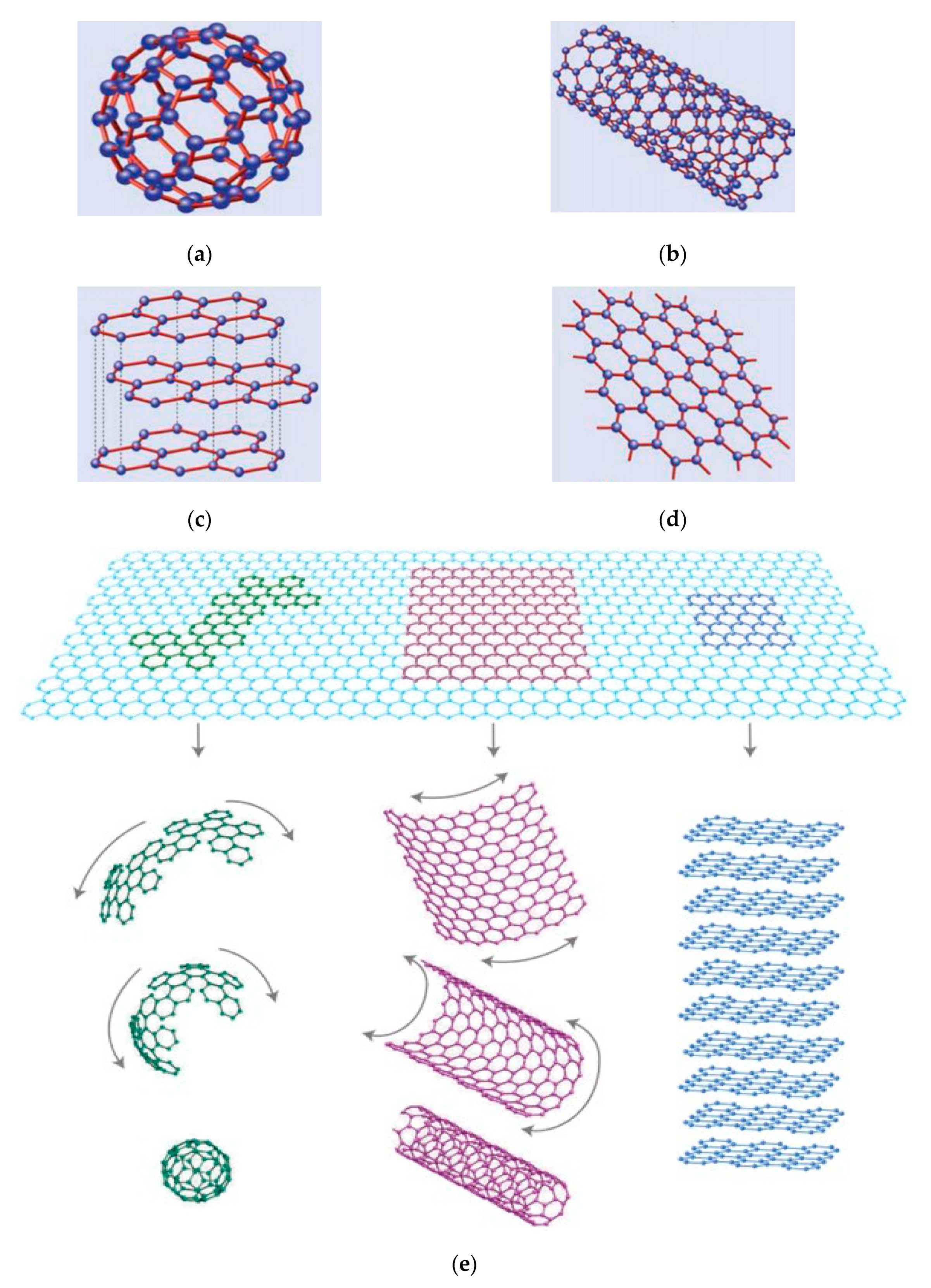
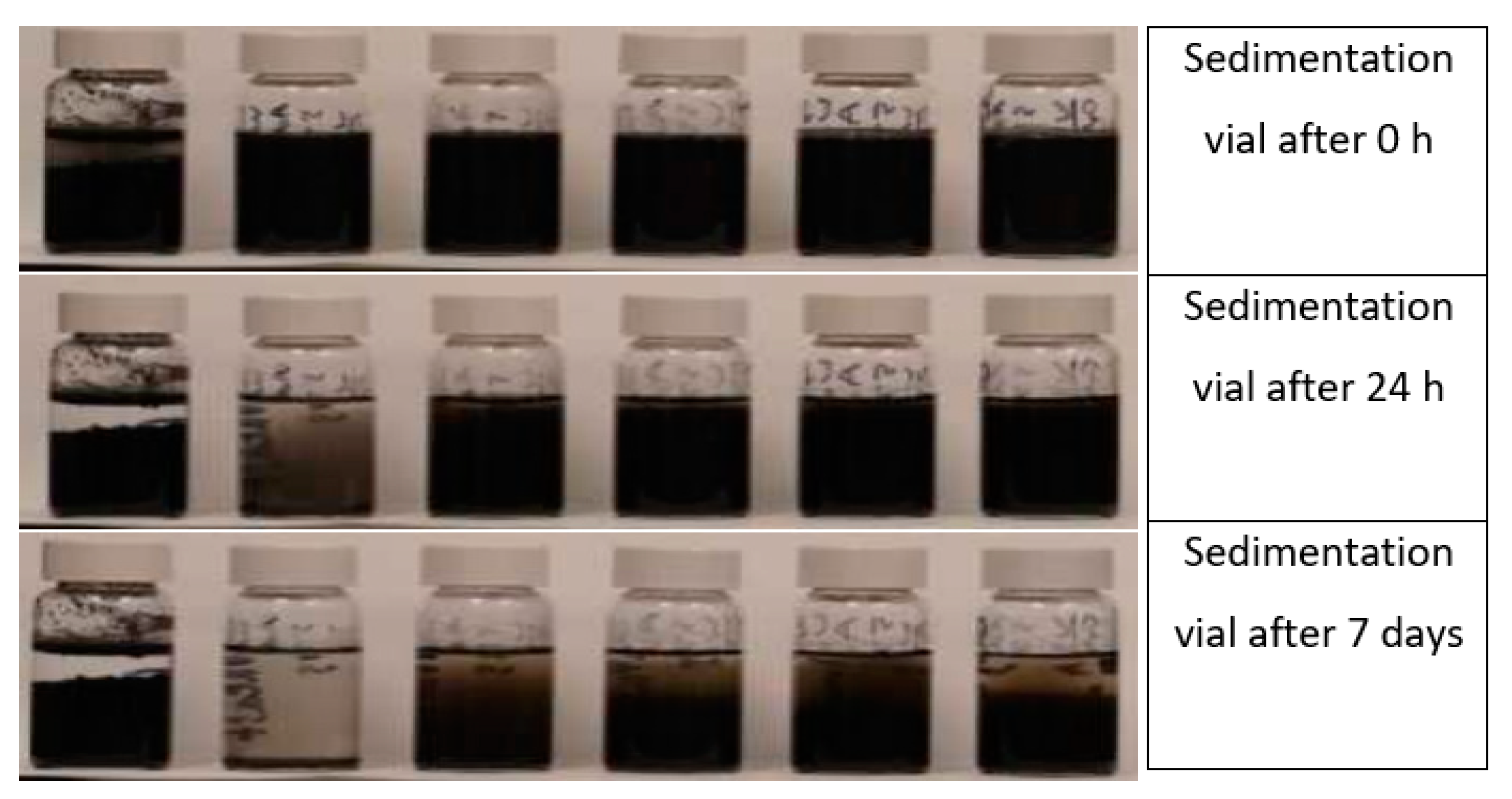


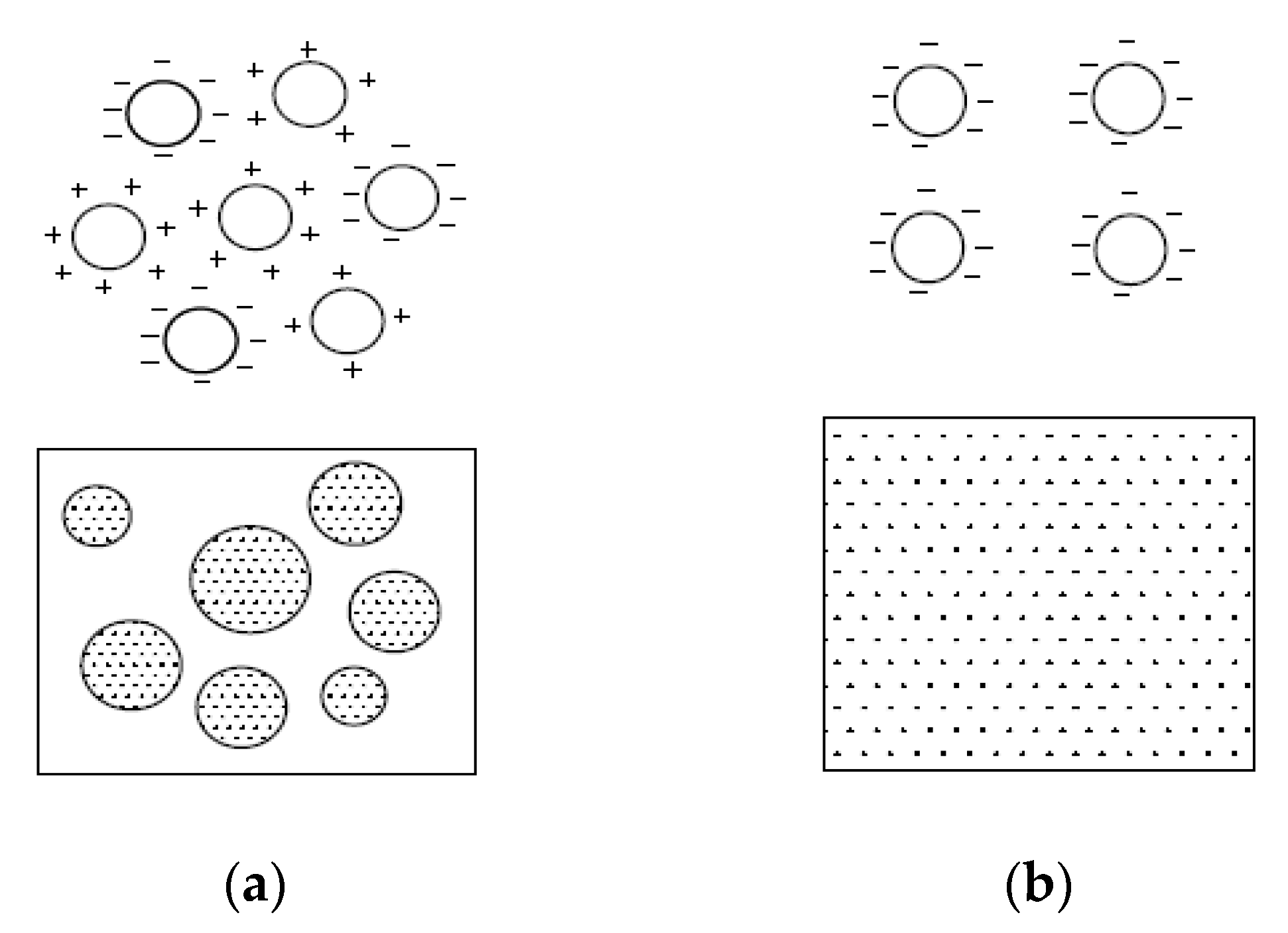
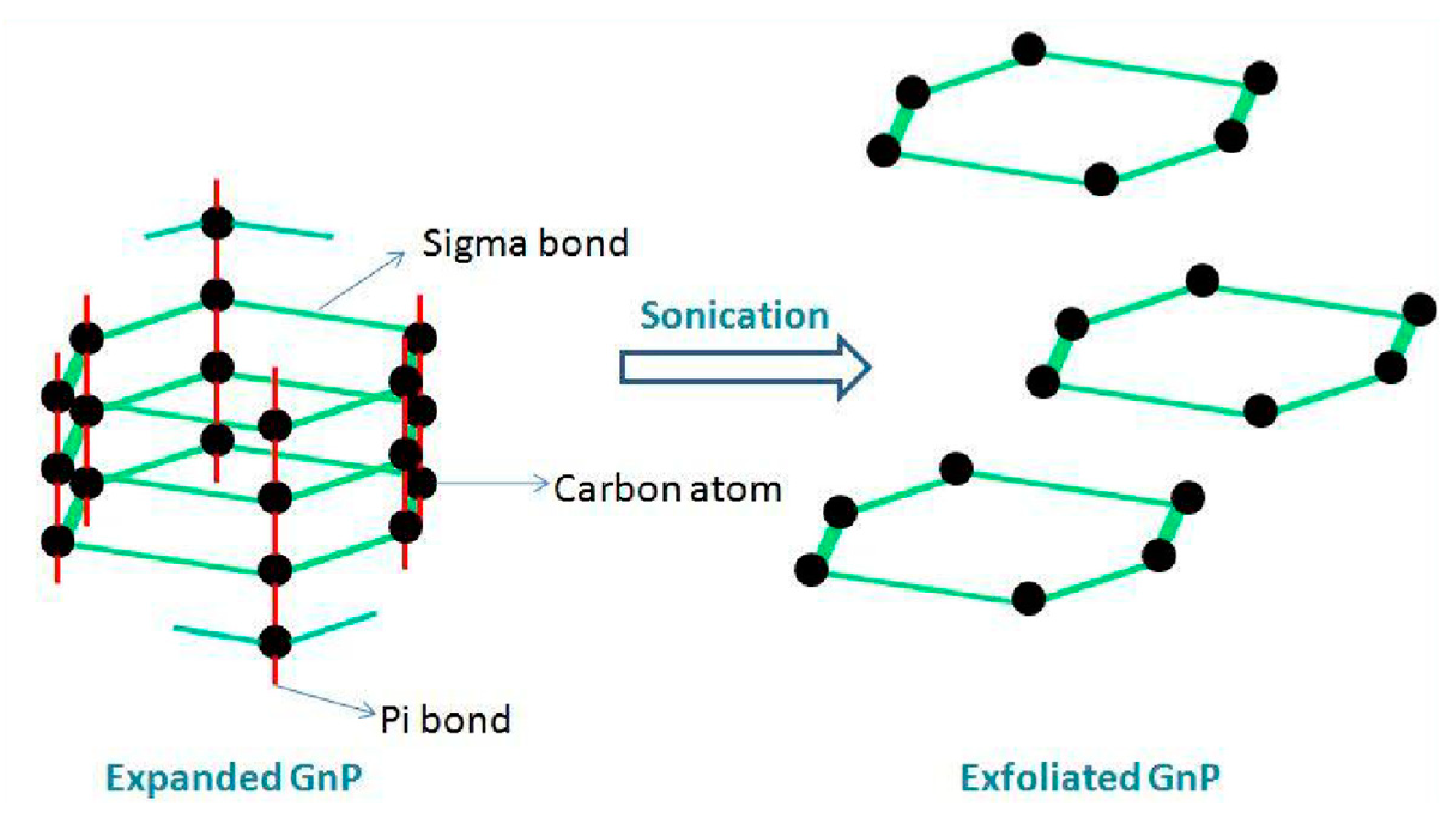
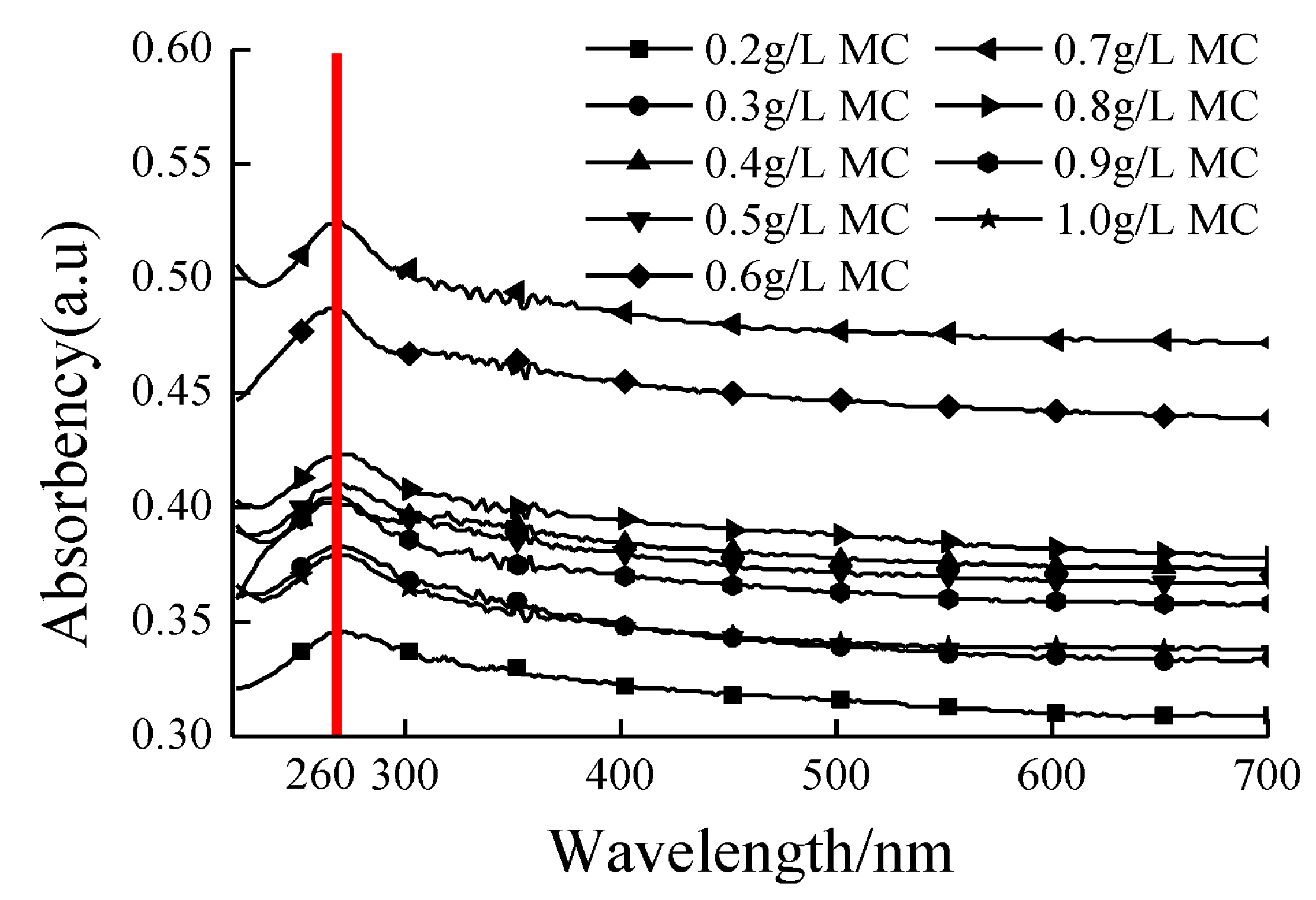
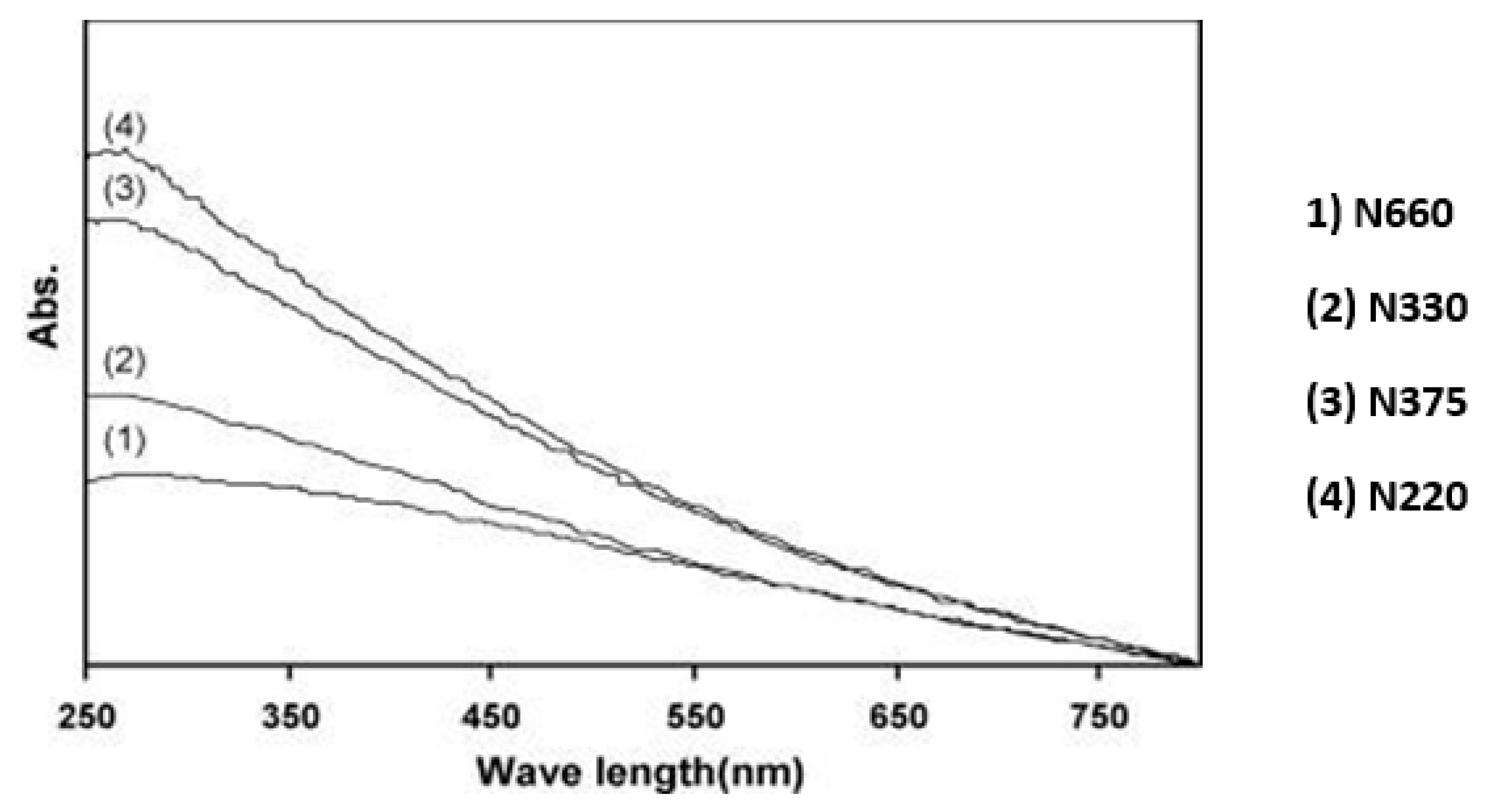
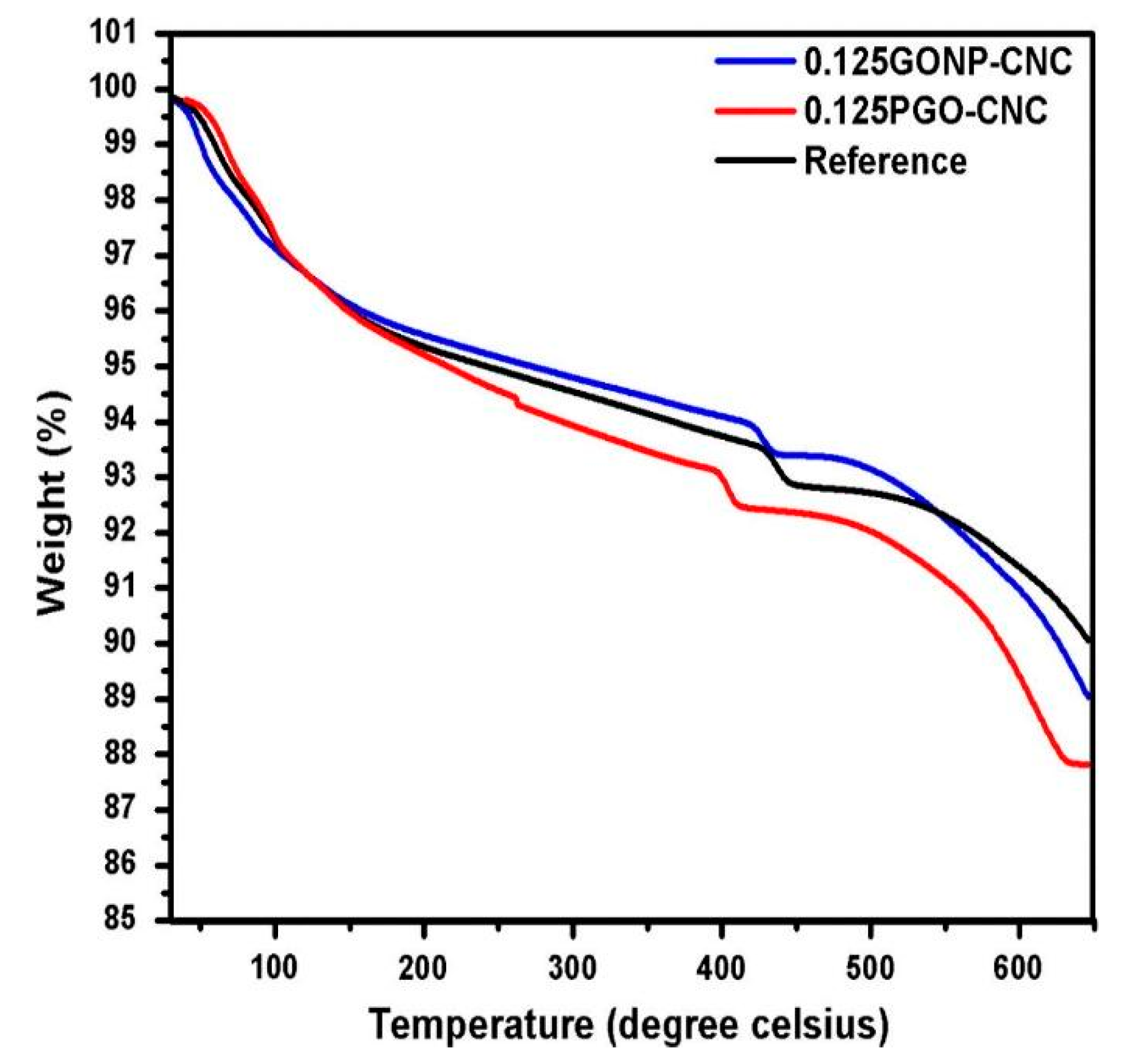
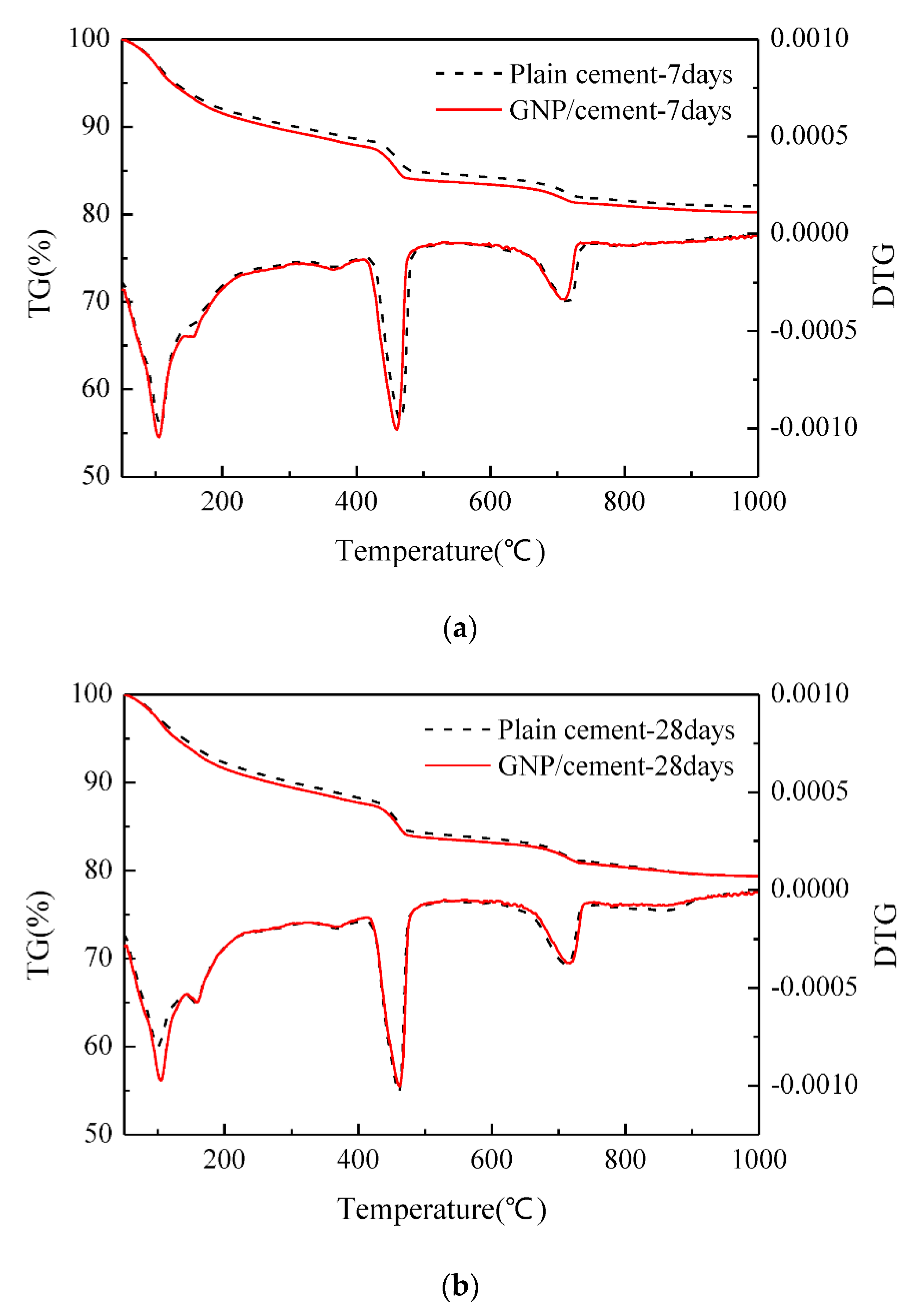

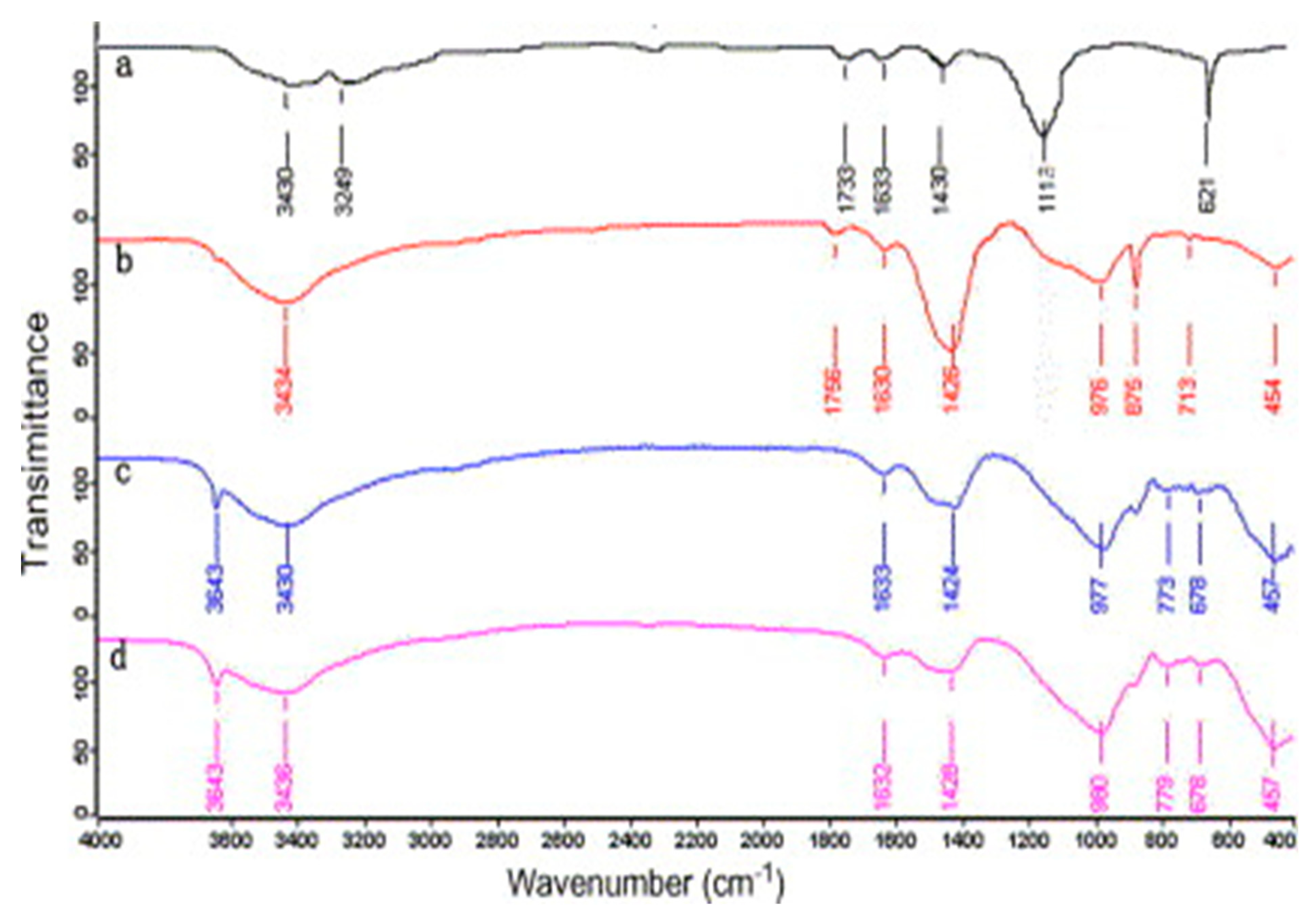
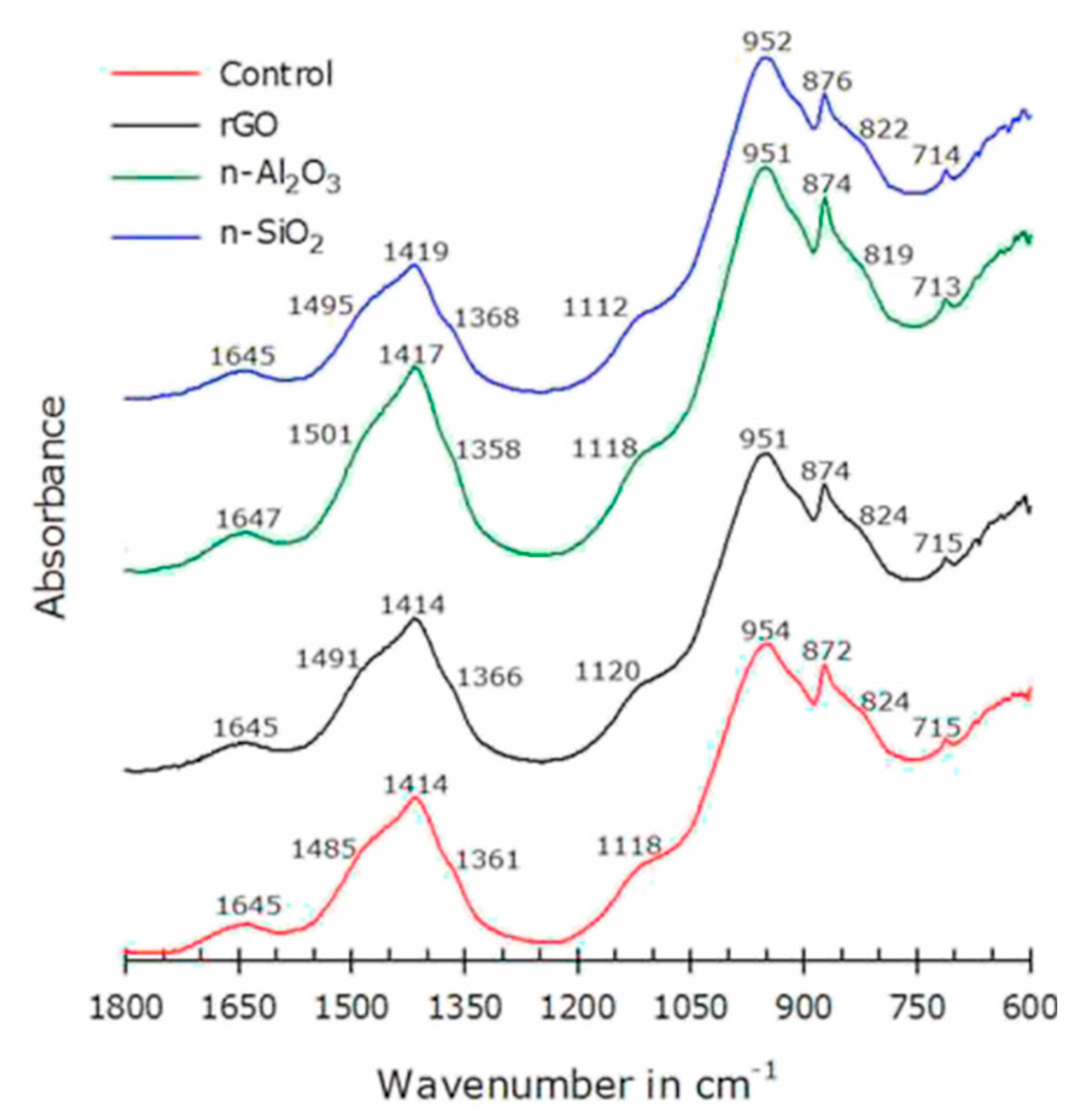

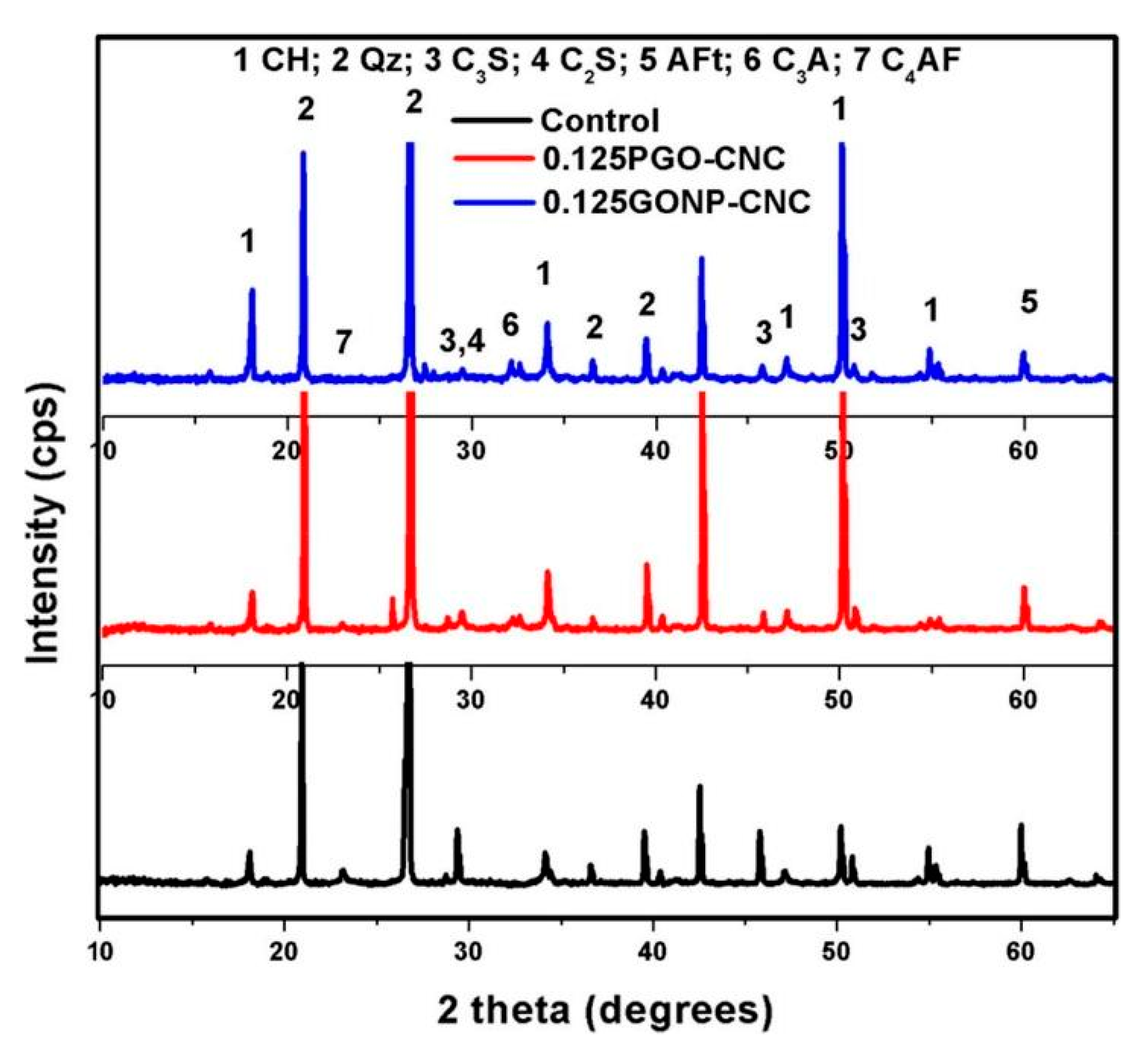
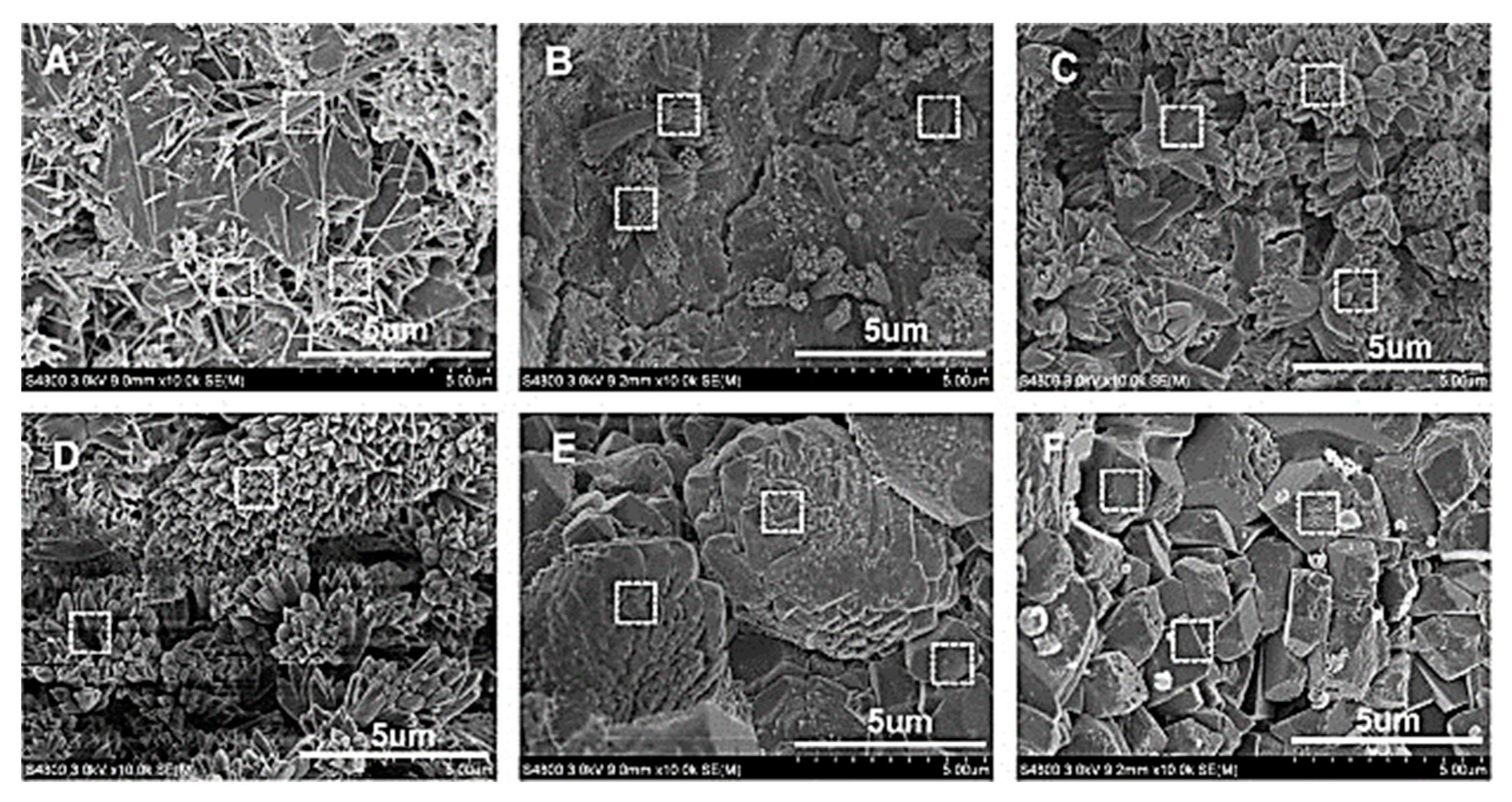

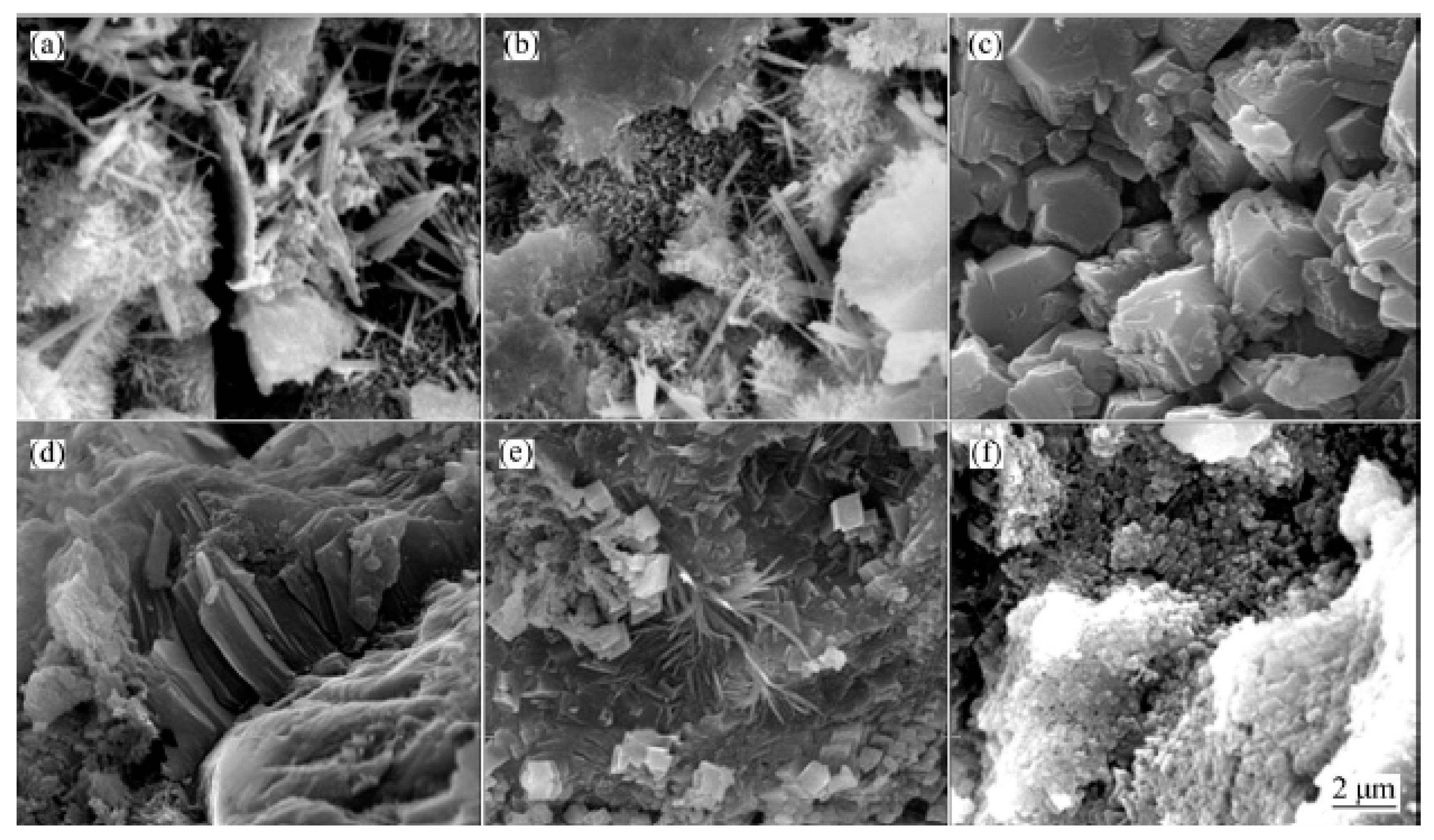
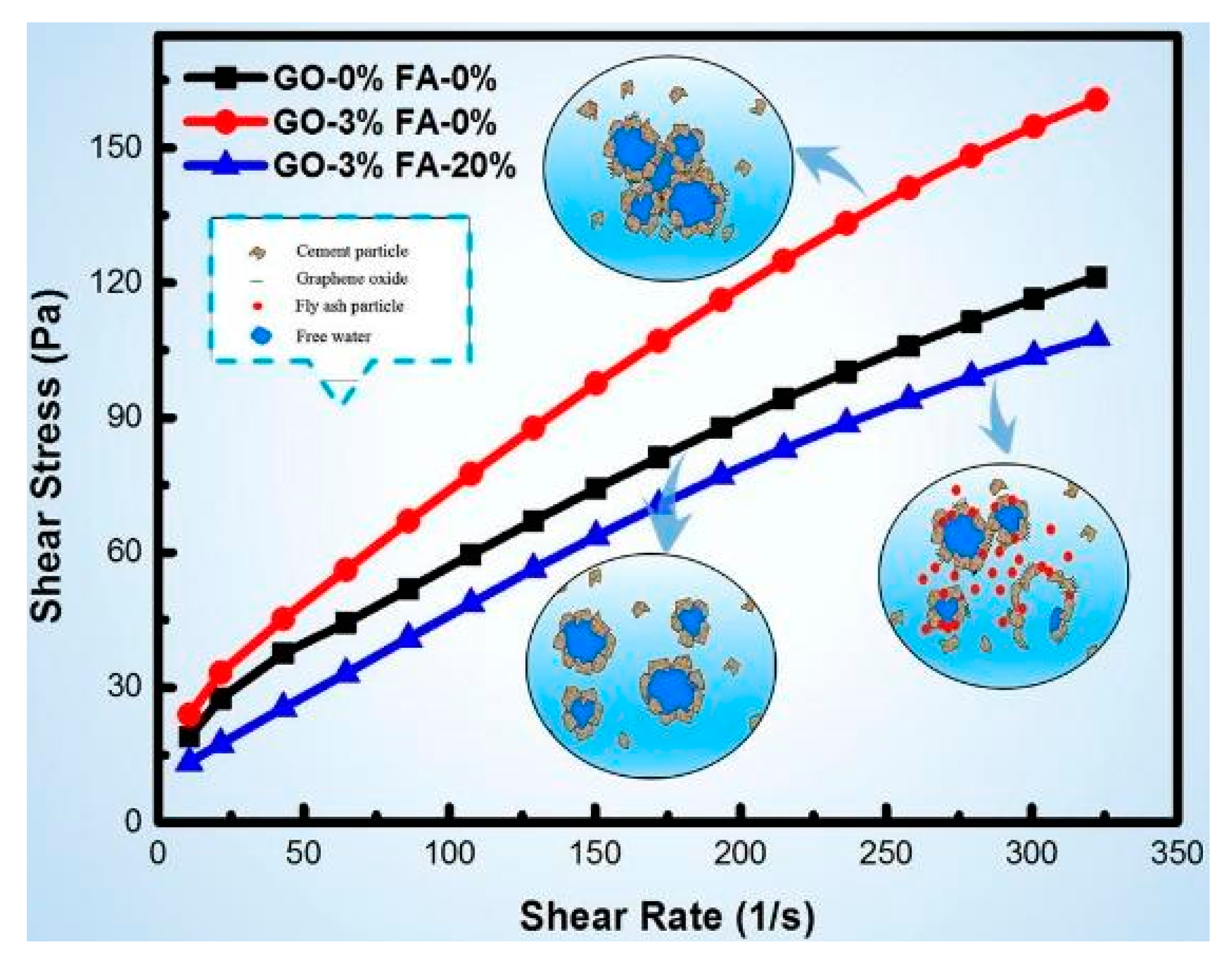
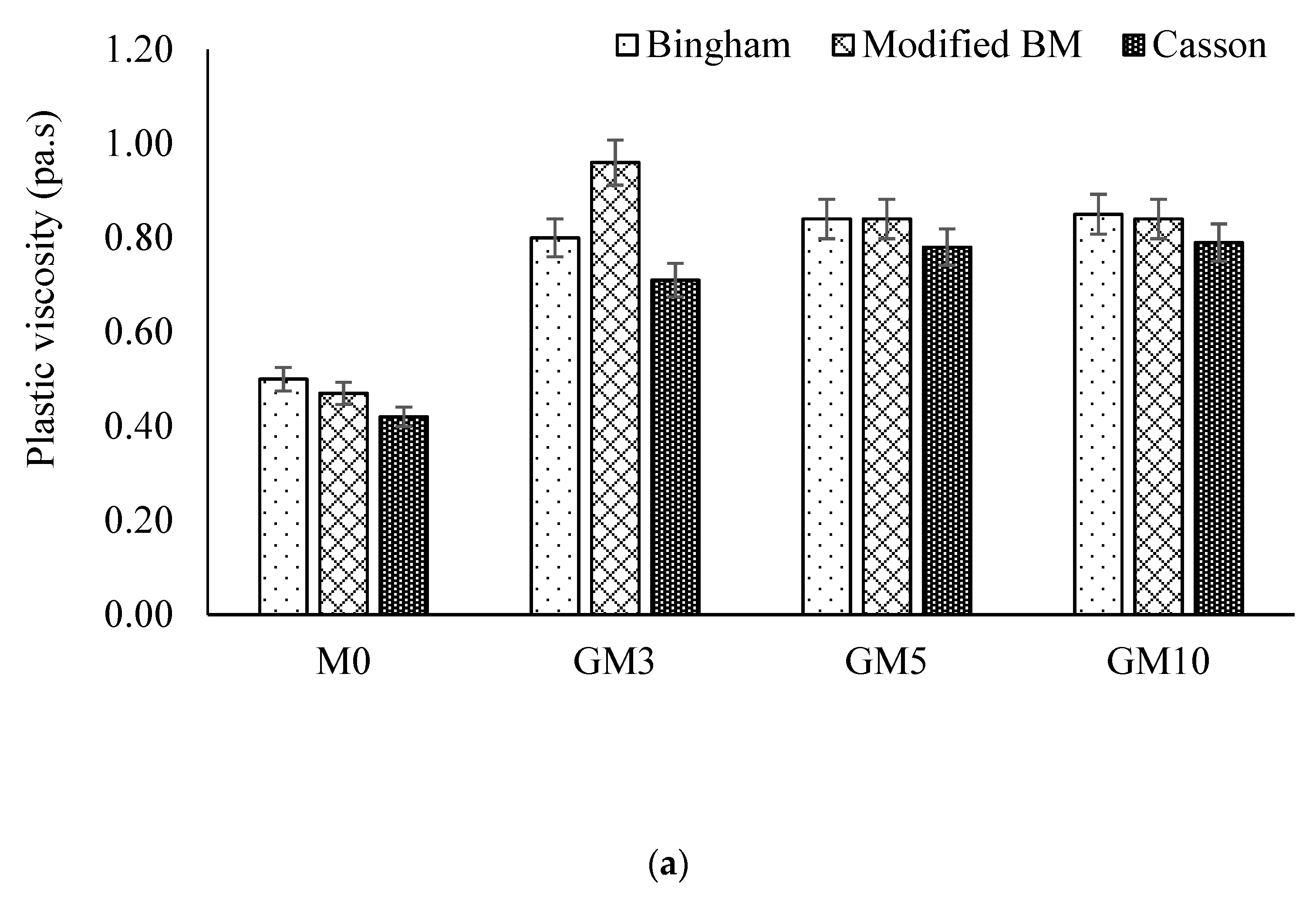
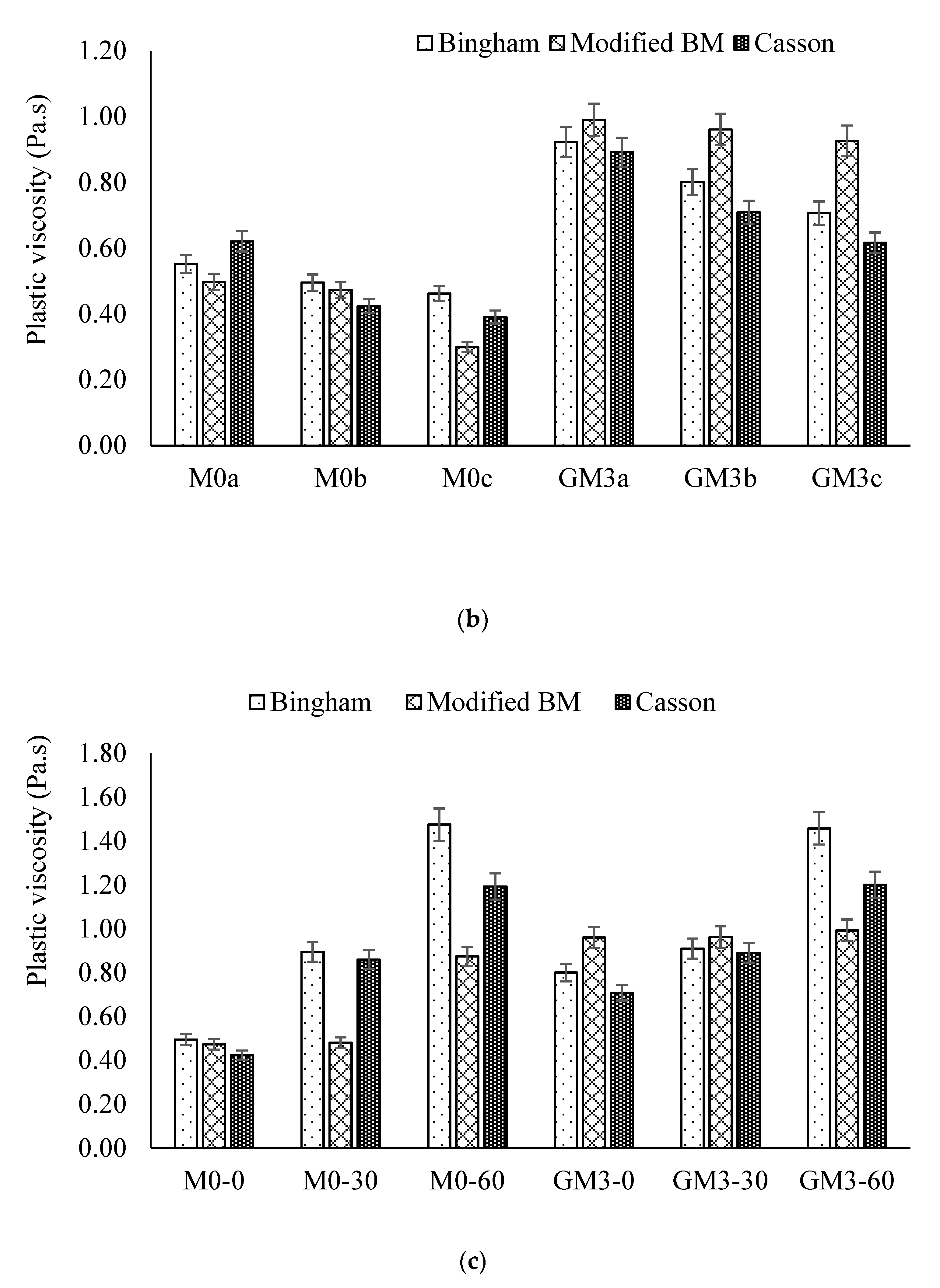
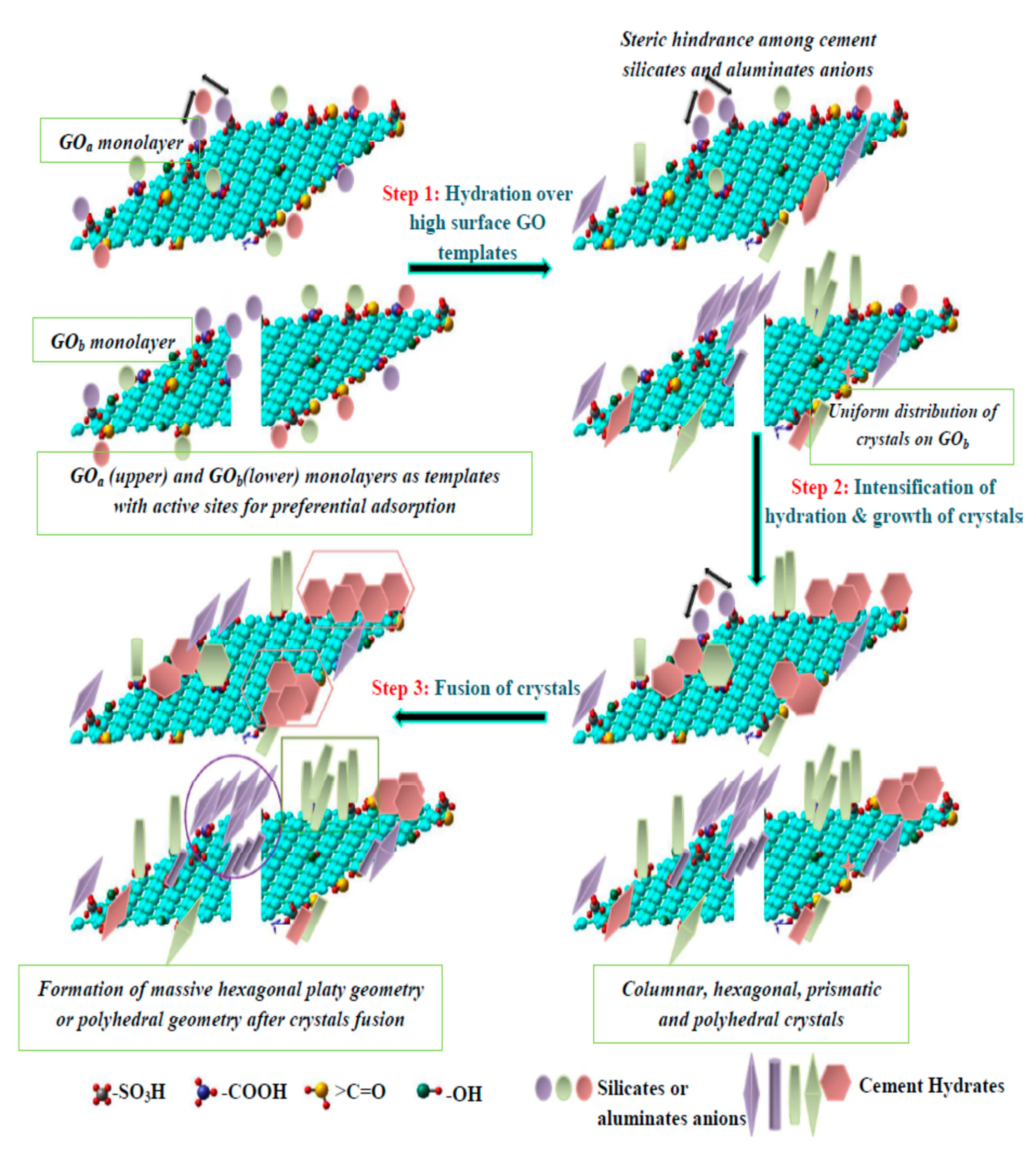
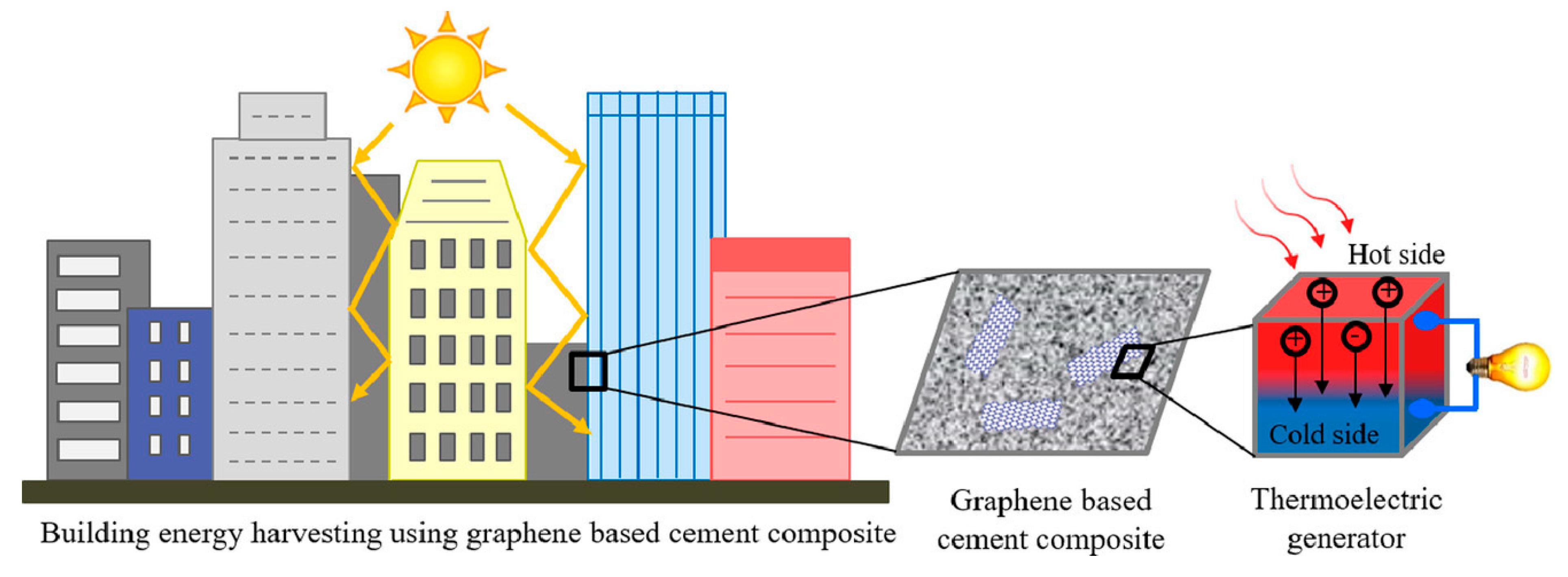


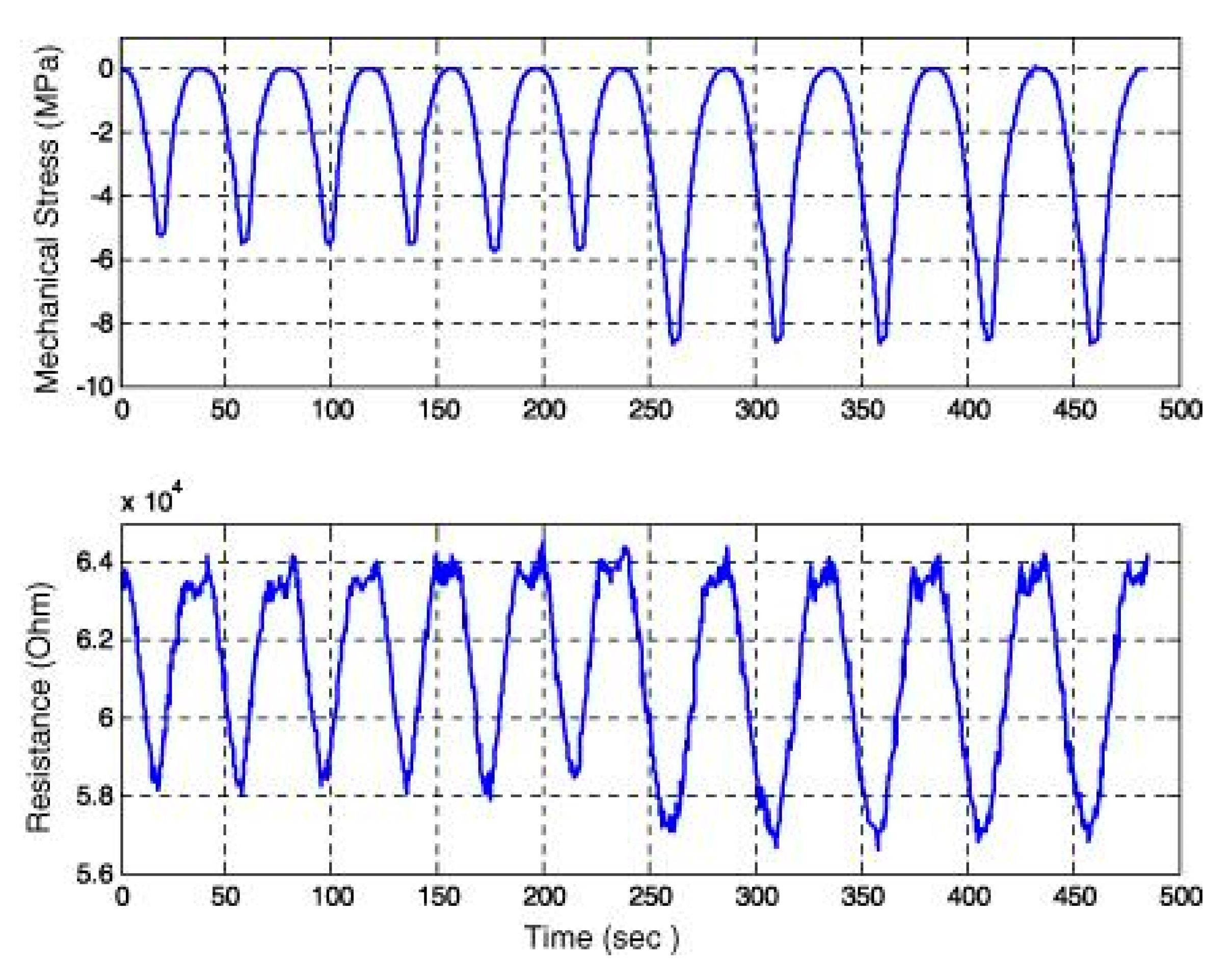
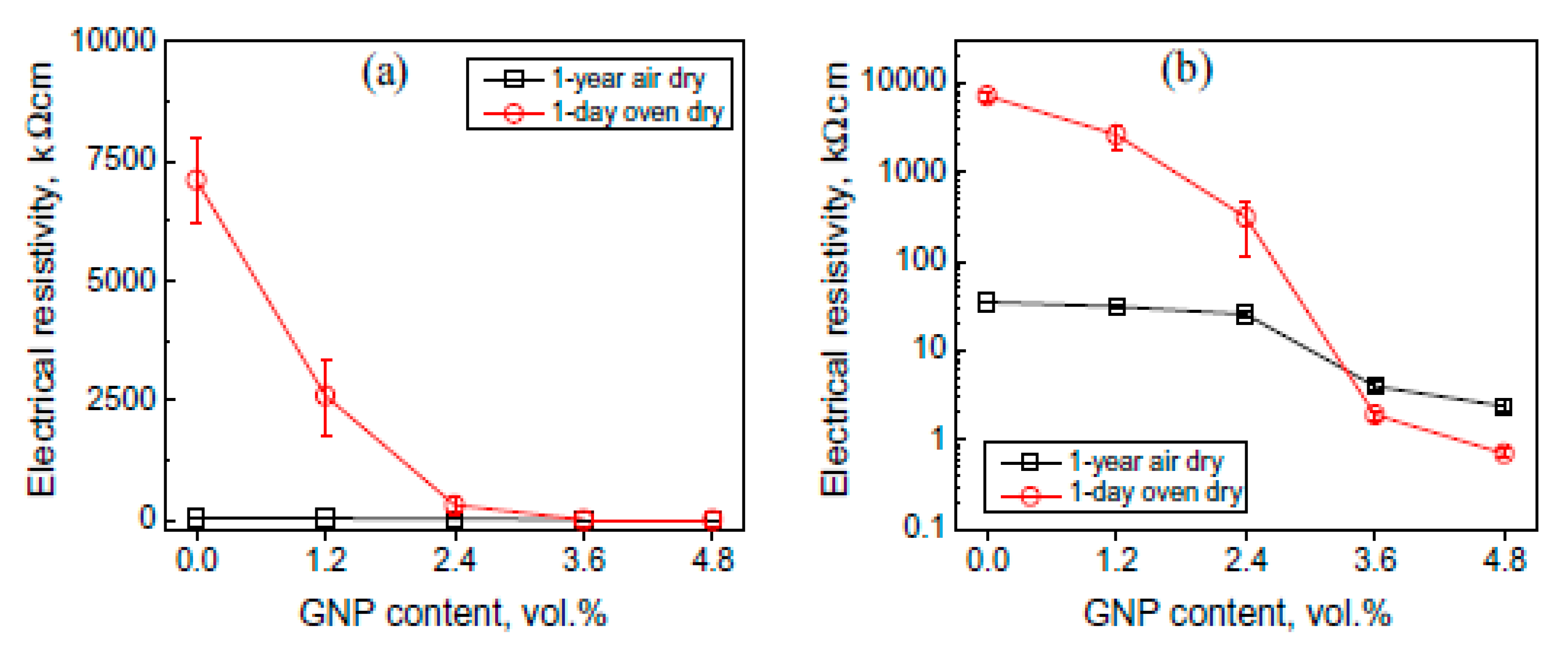
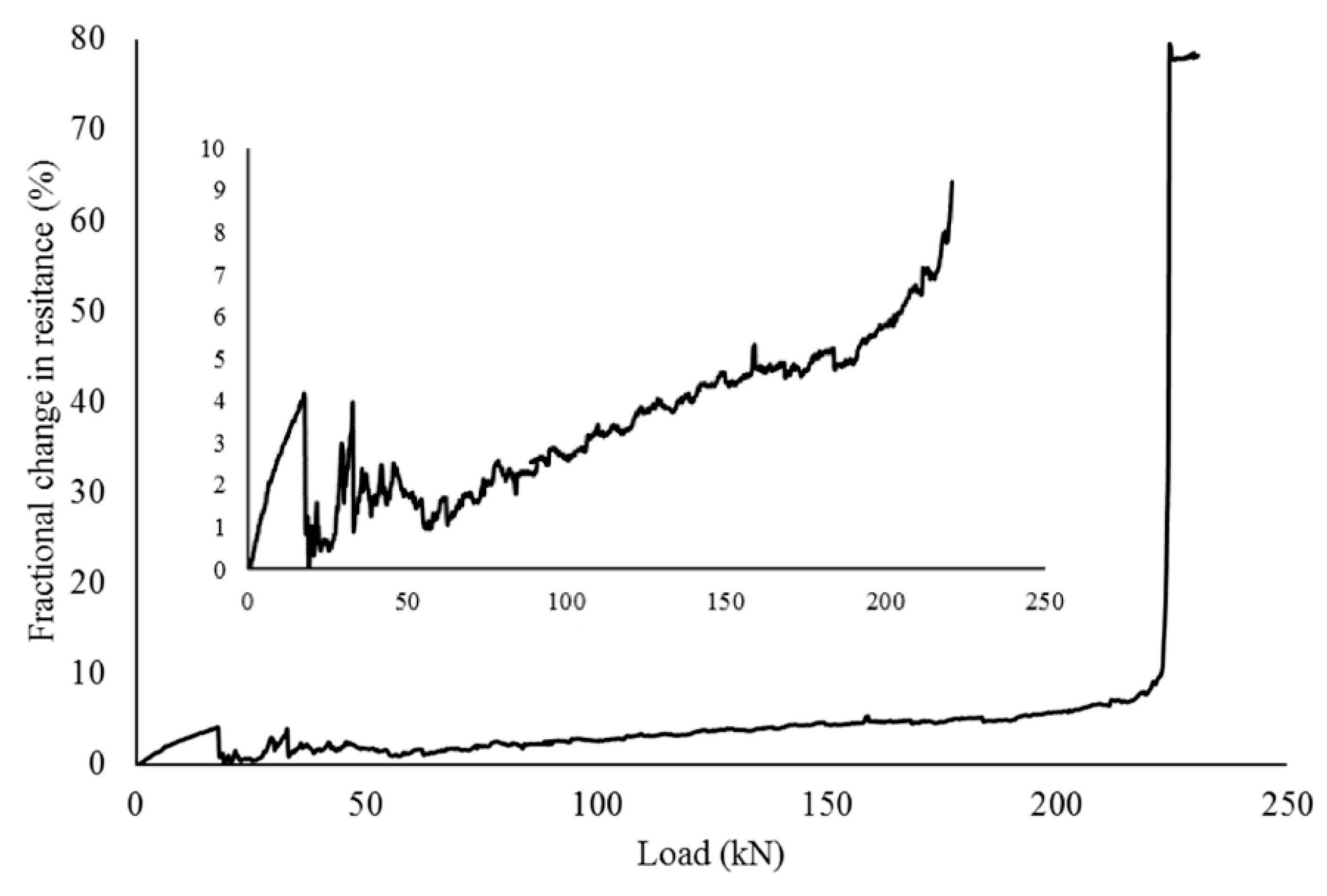
| π-π* Transition of rGO | References |
|---|---|
| 275 nm | [89] |
| 273 nm | [90] |
| 273 nm | [89] |
| 272 nm | [91] |
| 271 nm | [92] |
| 271 nm | [93] |
| 270.9 nm | [94] |
| 270 nm | [95] |
| 269 nm | [96] |
| 269 nm | [97] |
| 269 nm | [98] |
| 267 nm | [99] |
| 266 nm | [100] |
| 265 nm | [101] |
| 264 nm | [102] |
| 263 nm | [103] |
| 261 nm | [104] |
| 260 nm | [105] |
| Bond Type | Wavelength (cm−1) |
|---|---|
| H-O-H stretching of CSH | 3375 |
| Si-O asymmetric stretching vibrations of CSH | 1014 |
| Si-O in-plane vibration of CSH | 460 |
| Si-O out of plane vibration of CSH | 690 |
| C-O Stretching of CO3−2 | 1410 |
| C-O Stretching of CO3−2 | 874 |
| C-O Stretching of CO3−2 | 712 |
| H-O-H stretching of ettringite | 1630 |
| H-O-H stretching of ettringite | 3430 |
| S-O bending vibration of SO4−2 | 695 |
| C=O, C=C, O=O | 2299 |
| C=O, C=C, O=O | 2075 |
| Matrix | Nanomaterial Type/Dosage (wt.%) | w/b | Percentage Rise in Compressive Strength/Age | Percentage Rise in Flexural Strength/Age | Reference |
|---|---|---|---|---|---|
| Cement Paste specimens | GO/0.02 | 0.3 | 13.0/28 d | 41.0/28 d | [134] |
| 60.1/28 d | 84.5/28 d | [133] | |||
| rGO/0.02 | 22.0/28 d | 70.0/7 d | [114] | ||
| GO/0.03 | 18.8/28 d | 56.6/28 d | [135] | ||
| 42.5/28 d | 55.0/28 d | [127] | |||
| FGON/0.03 | 51.3/28 d | 65.5/28 d | [140]] | ||
| GO/0.04 | 28.6/28 d | 43.2/28 d | [144] | ||
| GO/0.05 | 66.4/7 d | 69.4/7 d | [145] | ||
| 52.4/3 d | 90.5/28 d | [146] | |||
| GNPs/0.15 | 49.4/28 d | 27.5/28 d | [147] | ||
| GO/0.022 | 0.4 | 27.6/3 d | 26.7/3 d | [148] | |
| GNPs/0.03 | 1.3/28 d | 16.8/28 d | [33] | ||
| 30/28d d | - | [118] | |||
| GO/0.04 | 37.0/28 d | 14.2/28 d | [132] | ||
| 15.1/28 d | – | [125] | |||
| GO/0.05 | 11.0/15 d | 16.2/15 d | [149] | ||
| GO-CNT/0.05 | 21.1/15 d | 24.1/15 d | [149] | ||
| GO-CNFs/0.05 | 2.89/28 d | 25.0/28 d | [150] | ||
| GO-CNT/0.06 | 23.9/28 d | 16.7/28 d | [151] | ||
| GO/0.03 | 0.5 | 40.0/28 d | – | [152] | |
| Cement Mortar Specimens | GO/0.022 | 0.4 | – | 34.1/7 d | [153] |
| GO/0.03 | – | 18.7/7 d | [154] | ||
| 45.1/3 d | 70.7/3 d | [155] | |||
| GO/0.05 | 43.2/3 d | 106.4/14 d | [146] | ||
| GO/0.02 | 0.5 | – | 36.7/3 d | [156] | |
| GO/0.03 | 30.0/28 d | – | [157] | ||
| FGON/0.03 | 20.3/28 d | 32.0/28 d | [158] | ||
| FGON/0.1 | 39.0/15 d | 70.8/15 d | [139] | ||
| GNPs/0.1 | 19.9/28 d | – | [159] | ||
| GO/0.125 | 110.7/3 d | – | [136] | ||
| 53.0/3 d | – | [107] | |||
| GNPs/0.8 | 87.5/28 d | – | [160] | ||
| GO/1.0 | 114.1/14 d | – | [138] | ||
| GNPs/0.08 | 0.6 | 55.3/7 d | – | [161] | |
| Concrete | GO/0.1 | 0.5 | 14.2/7 d | 4.0/3 d | [162] |
| Materials | Concentration (wt.%) | S (µV/°C) | σ (Scm−1) | K (Wm−1K−1) | Power Factor (µWm−1K−2) | Reference |
|---|---|---|---|---|---|---|
| Control sample without nanomaterial | 0 | 10−5–10−4 | 10−7 | 0.53 | [166] | |
| Expanded Graphite | 5 | −54.5 | 0.2 | 1.619 | 0.1 | [166] |
| 10 | −51.5 | 7.4 | 2.594 | 1.9 | [166] | |
| 15 | −50.1 | 24.8 | 3.213 | 6.38 | [166] | |
| Carbon nanotubes | 15 | 57.98 | 0.818 | 0.947 | - | [167] |
| Graphene nanoplatelets | 5 | 32 | 3.13 | 0.743 | 0.4 | [164] |
| 10 | 30 | 8.5 | 0.947 | 0.7 | [164] | |
| 15 | 34 | 11.68 | 1.067 | 1.25 | [164] | |
| 20 | 31 | 16.2 | 1.327 | 1.6 | [164] | |
| n-doped CNT (before drying) | 1 | −500 | 0.0173 | - | 0.435 | [168] |
| n-doped CNT (after drying) | 1 | −58 | 0.0219 | - | 0.007 | [168] |
| p-doped CNT (before drying) | 1 | −112 | 0.0054 | - | 0.009 | [168] |
| n-doped CNT (after drying) | 1 | 20 | 0.0069 | - | 0.0002 | [168] |
| Sr. No. | Nomenclature | Description | Reference |
|---|---|---|---|
| Nanomaterials | |||
| 1. | Graphene | Graphene is single layer of densely packed carbon atoms in benzene- ring structure in 2-dimensions (2D). sp2 interacted carbon atoms are conned tightly and forms honeycomb lattice. | [88] |
| 2. | Rolled sheets of graphene (CNT) | Carbon nanotubes (CNT) consist of sp2 carbon atoms arranged in honeycomb lattice in 1-dimension (1D) and capped with fullerene-like hemisphere at each end. They are also conceptualized as 1D rolled sheets of graphene. | [181,182] |
| 3. | Graphene Oxide (GO); | Graphene Oxide (GO) is derived from graphene sheets and known as oxidized form of graphene. A mixture of carboxyl, hydroxyl and epoxide groups are attached chemically (covalent linkage) with graphene sheets. | [21,55,183] |
| 4. | Graphite oxide, | Graphite oxide is identical chemically to Graphene oxide, However, inter-planar spacing between them vary due to oxidation process. | [184,185] |
| 5. | Functionalized Graphene | Attaching various functional groups like epoxide, hydroxyl and carboxyl group with Graphene through covalent linkage is known as Functionalized graphene. | [21] |
| 6. | Graphite/Three- dimensional graphite/Graphite structure/ Expanded graphite structure | 3-D carbon allotrope containing minute crystallite of graphite. It is made of stacked graphene sheets with 0.345 nm spacing. | [186,187,188] |
| 7. | 2D flat sheet of carbon nanomaterial | Single layer graphene sheet is also known as 2D flat sheet of carbon nanomaterial. | |
| 8. | Pristine graphene oxide (PGO) | Graphene oxide in its original condition (i.e., Ideal) and does not have a single defect. | |
| 9. | Reduced graphene oxide (RGO) | Reduced graphene oxide (RGO) are prepared from oxidation, exfoliation and chemical reduction of graphite oxide. | [189] |
| 10. | Reduced graphite oxide (rGO) | Main difference between reduced graphene oxide and Reduced graphite oxide is inter-planer spacing between atomic layers of the compound. | [184,185] |
| 11. | Graphene and its derivatives (GNDs) | Various structural form of graphitic structure in 0D (carbon materials), 1D (CNTs), 2D (graphene sheets) and 3D (Naturally available graphite). | |
| Flakes | |||
| 12. | Graphene flakes (GNFs) | Graphene flakes are small tiny particles, which are much easier to form and handle in solution and powder form as compared with large graphene sheets. These GNFs possess some of the properties of large graphene sheets however; they vary with shape and size of tiny particles. Furthermore, maintaining uniform consistency in shape and sizes is not easy during synthesis process. Graphene flakes (GNFs) are also labelled as graphene nanoplatelets (GNPs). | [190] |
| 13. | Graphene oxide flakes | Formation and production of graphene oxides in small tiny particles in powder or solution form is known as Graphene Oxide flakes. | [190] |
| 14. | Exfoliated graphene flakes | Exfoliated large size graphene flakes/particles/sheets | |
| Nanoplatelets | |||
| 15. | Graphene Nanoplatelets (GNPs) | Graphene Nanoplatelets (GNPs) are small rounded disk-shaped tiny particles, However, it is difficult to uniformly produce them even if synthesized artificially. Theoretically, all GNPs are not disk-shaped particles, therefore should be considered as Graphene flakes (GNFs). | [191] |
| 16. | Graphite Nanoplatelets (GnPs or GPs) | Graphite Nanoplatelets are composed of mixture of graphene layers with thicker graphite particles. Their chemical structure is in-between graphene and graphite. Some researchers also consider them as graphene nanoplatelets, which is not true as per authors’ point of view. Hence, their common nomenclature consist of Graphite Nanoplatelets (GnPs) and Graphite platelets (GPs). | [191] |
| 17. | Graphene Oxide nanoplatelets (GONPs) | Graphene Oxide nanoplatelets (GONPs) consist of small rounded disk-shaped particles of graphene oxide in powder or solution form. | [190] |
| 18. | Functionalized Graphene Sheets/flakes and nanoplatelets | Attaching various functional groups like epoxide, hydroxyl and carboxyl group with Graphene sheets/flakes/nanoplatelets through covalent linkage is known as Functionalized graphene sheets/flakes/nanoplatelets. | [21] |
| 19. | Graphite nanoparticles, Graphite flakes, Graphite particles, Nano graphite platelets | Graphite flakes have the large size while graphite nanoparticles possess small size. Graphite nanoplatelets (GNPs) with a thickness in nanometer scale, can be obtained by exfoliation of natural graphite flakes. | [73] |
Publisher’s Note: MDPI stays neutral with regard to jurisdictional claims in published maps and institutional affiliations. |
© 2020 by the authors. Licensee MDPI, Basel, Switzerland. This article is an open access article distributed under the terms and conditions of the Creative Commons Attribution (CC BY) license (http://creativecommons.org/licenses/by/4.0/).
Share and Cite
Kashif Ur Rehman, S.; Kumarova, S.; Ali Memon, S.; Javed, M.F.; Jameel, M. A Review of Microscale, Rheological, Mechanical, Thermoelectrical and Piezoresistive Properties of Graphene Based Cement Composite. Nanomaterials 2020, 10, 2076. https://doi.org/10.3390/nano10102076
Kashif Ur Rehman S, Kumarova S, Ali Memon S, Javed MF, Jameel M. A Review of Microscale, Rheological, Mechanical, Thermoelectrical and Piezoresistive Properties of Graphene Based Cement Composite. Nanomaterials. 2020; 10(10):2076. https://doi.org/10.3390/nano10102076
Chicago/Turabian StyleKashif Ur Rehman, Sardar, Sabina Kumarova, Shazim Ali Memon, Muhammad Faisal Javed, and Mohammed Jameel. 2020. "A Review of Microscale, Rheological, Mechanical, Thermoelectrical and Piezoresistive Properties of Graphene Based Cement Composite" Nanomaterials 10, no. 10: 2076. https://doi.org/10.3390/nano10102076
APA StyleKashif Ur Rehman, S., Kumarova, S., Ali Memon, S., Javed, M. F., & Jameel, M. (2020). A Review of Microscale, Rheological, Mechanical, Thermoelectrical and Piezoresistive Properties of Graphene Based Cement Composite. Nanomaterials, 10(10), 2076. https://doi.org/10.3390/nano10102076








